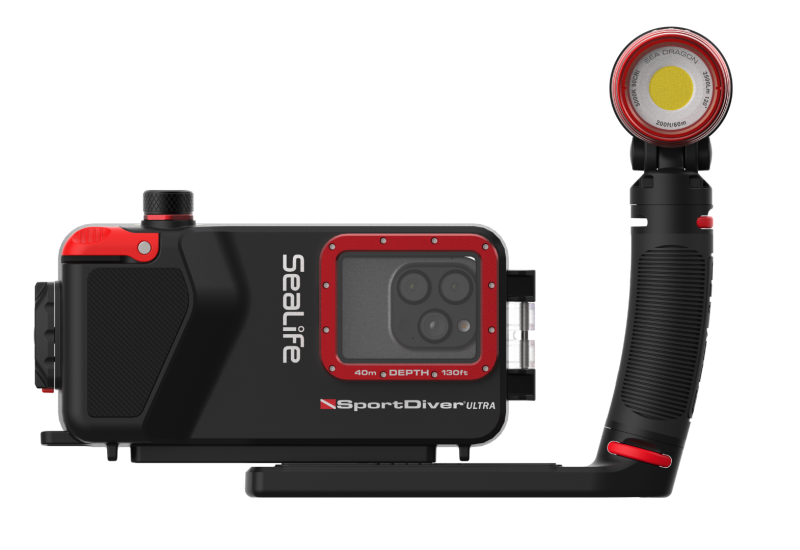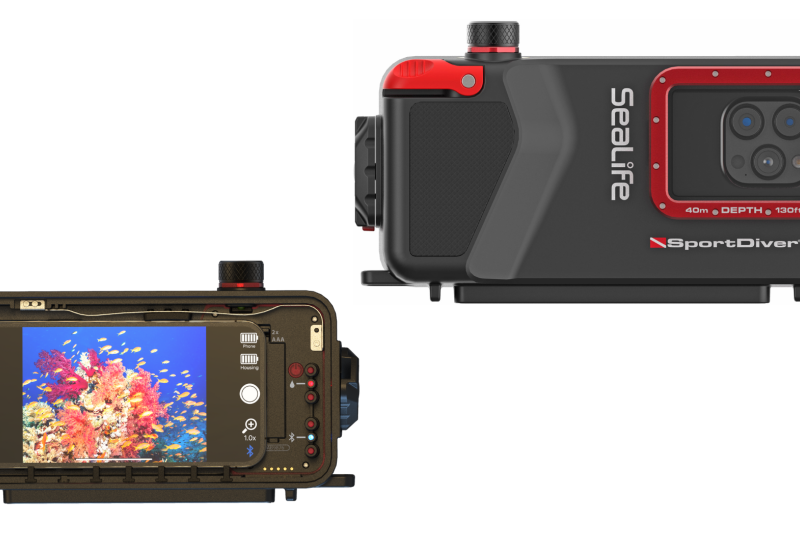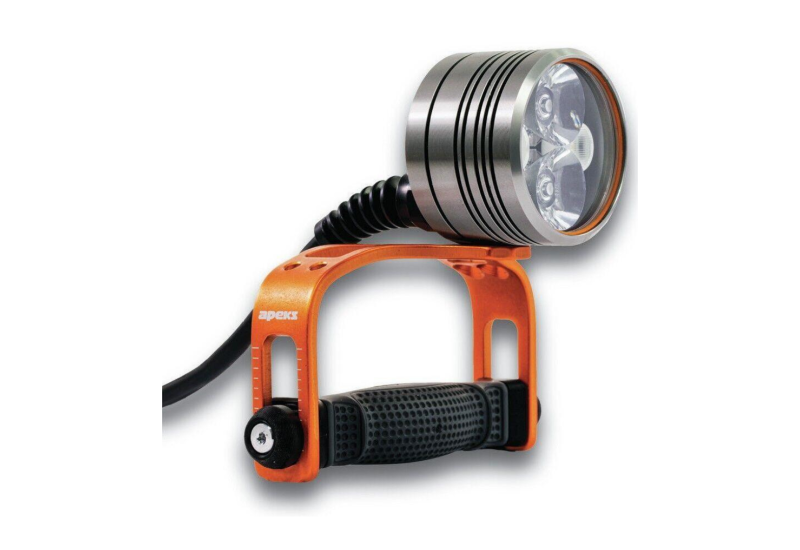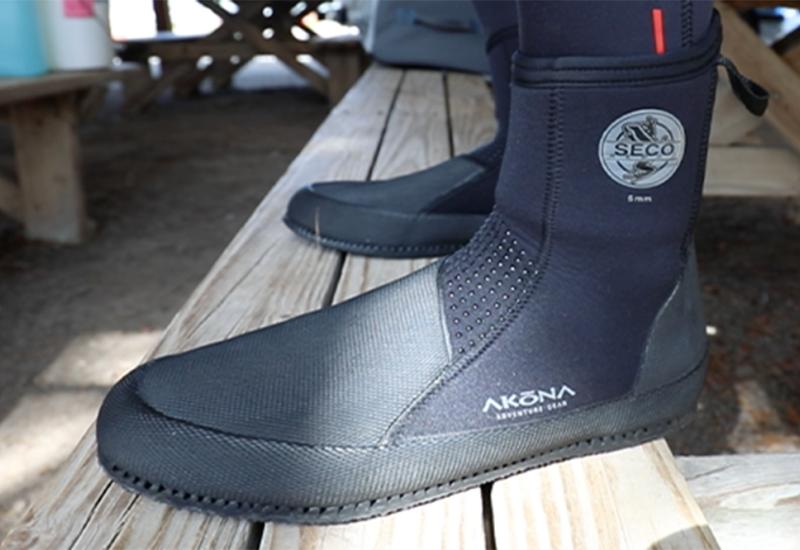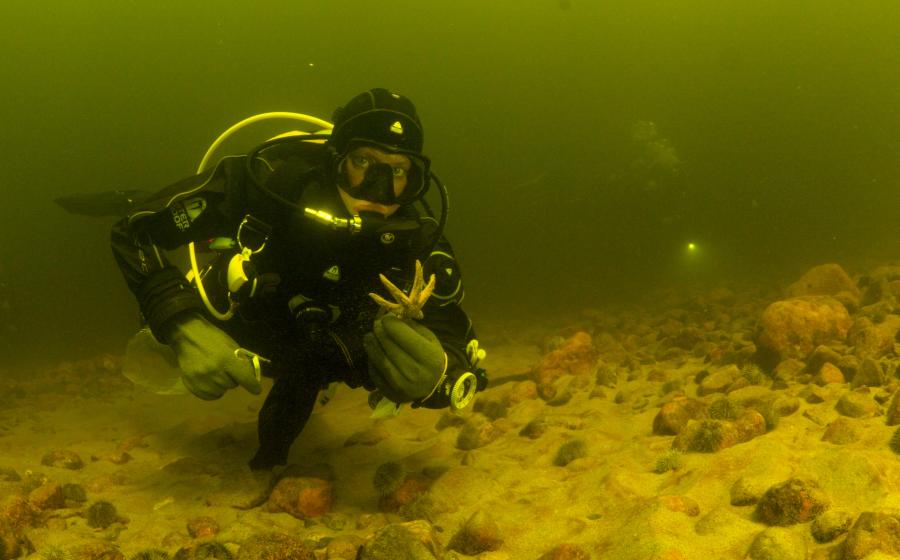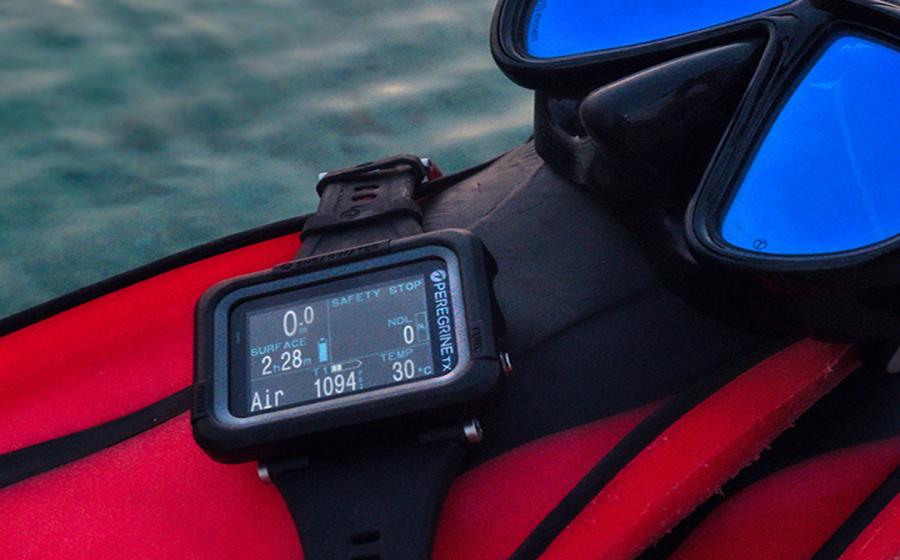Dive Knife Review
You want a dive knife that is sharp, strong and resistant to corrosion. We evaluated new knives in a variety of designs, materials and sizes so you'd know how they stand up to the rigors of dive use.
Choosing the Best Material
Finding the perfect metal for a dive knife is almost as much alchemy as metallurgy. Whether made from 1) titanium or one of the many types of 2) stainless or specialty steels now used, all knives have to strike a rock/paper/scissors sort of balance: hard enough to hold an edge; strong enough to resist breaking; and able to avoid corrosion. With stainless, reducing carbon content increases corrosion resistance but at the expense of hardness needed to stay sharp. Materials like titanium and some specialty steels have extreme resistance to corrosion but may not hold an edge like high-carbon steels that would quickly rust in salt water.
How We Test
We evaluated each dive knife’s ability to cut several types of line: 1⁄4-inch diamond braid nylon-poly, 1⁄4-inch hollow-braid poly, 1⁄2-inch braided nylon and heavy (.095-inch) plastic trimmer line. While we could have used tougher lines (such as Kevlar), we chose the lines we did because they’re the kind of cheap, often-discarded, long-lived materials that we encounter diving. We made a first cut through a hand-held loop of each type of line, and rated the cutting ability from 1 to 5 (1=Poor and 5=Excellent). Next we cut a double thickness of each line, and then we made 20 repetitive cuts of all lines on a block of soft wood, and followed that with more cuts of hand-held loops (since you’re not likely to find a cutting board when diving). We also scored each knife on the following: the security of its sheath or folding/locking mechanism; the ease of deploying/stowing the knife barehanded and with 5 mm gloves; how it withstood 10 pounds of weight when wedged 1-inch deep in a block of wood; and its overall fit and finish.
Does Size Matter?
The short answer is yes, but not in the way you might expect. Some of the smaller blades here cut as well as the largest. But big dive knives have room for big, comfortable grips — something you notice after cutting nearly 200 feet of test line.
Finding the Perfect Style and Size
There are knives designed for dispatching speared fish, knives that will endure prying and pounding, knives that will cut fouled lines without hurting you or your gear, and knives so small, they stow anywhere. But like any tool, no single dive knife can be the best at everything. Whether your dive style means you need a knife that works for spearfishing and kelp diving, or one that stays safely out of the way until the day you find yourself tangled in discarded fishing line, there are many options available. Assess your needs honestly and shop accordingly.
Best Blade Design
How you’ll actually use your knife or cutting tool is what determines the best design for you. If you’re carrying it for emergency use to clear away entanglements like fishing line, a very compact cutting tool that stows out of the way might be the best option. But if you need a tool for heavy cutting, sawing or prying, you need a really rugged dive knife with a thick, tough blade and a secure grip. And if you’ll be using your knife for spearfishing as well as general diving, you need a blade that can cut well but also quickly dispatch a speared fish, and it’s handy if it has tools for repairing or freeing spear points. Also be sure that the knife’s grip fits your hand properly (including with any gloves you dive with).
Fighting Rust
Today’s dive knives resist rust far better than those of just a few years ago. Titanium and some specialized steel alloys are practically immune to corrosion, and even less-resistant steels can last a long time with proper care. First, rinse the knife and sheath thoroughly as soon as possible after use, being sure to remove any accumulated salt beneath the handle or hardware. If the knife handle is removable, pull it of for cleaning. Next, dry the knife completely, rubbing the blade and metal parts with a soft cloth to buff away any signs of corrosion or stain. Finally, spray the blade with a very light coat of silicone lubricant (don’t use petroleum oil), and store it in its sheath.
Looking for more ScubaLab testing? Check out more of our gear reviews:
SCUBALAB 2015: Travel Gear Review
SCUBALAB 2014: Gear of the Year
SCUBALAB 2014: Dive Bag Review
SCUBALAB 2014: Regulator Review
SCUBALAB 2014: BC Review
SCUBALAB 2014: Dive Lights Review
SCUBALAB 2014: Wetsuit Review
SCUBALAB 2013: Fins Review
SCUBALAB 2013: Mask Review
SCUBALAB 2013: Regulator Review
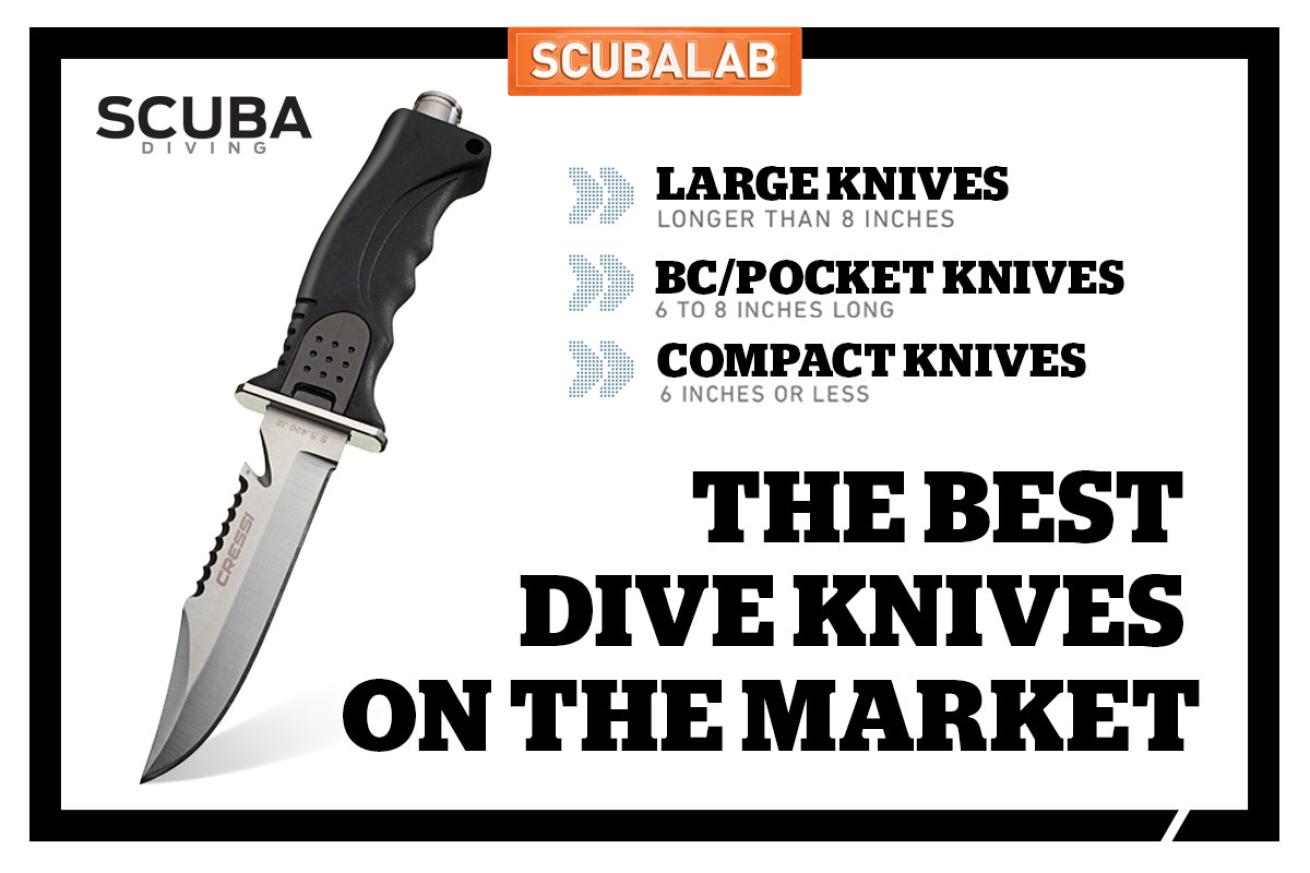
Michael KrausA review of the best diving knives you can buy.
Having the right dive knife can be a matter of life or death, so we put the industry's latest models to the test. Check out which knives performed a cut above the competition.
Cressi: Skorpion
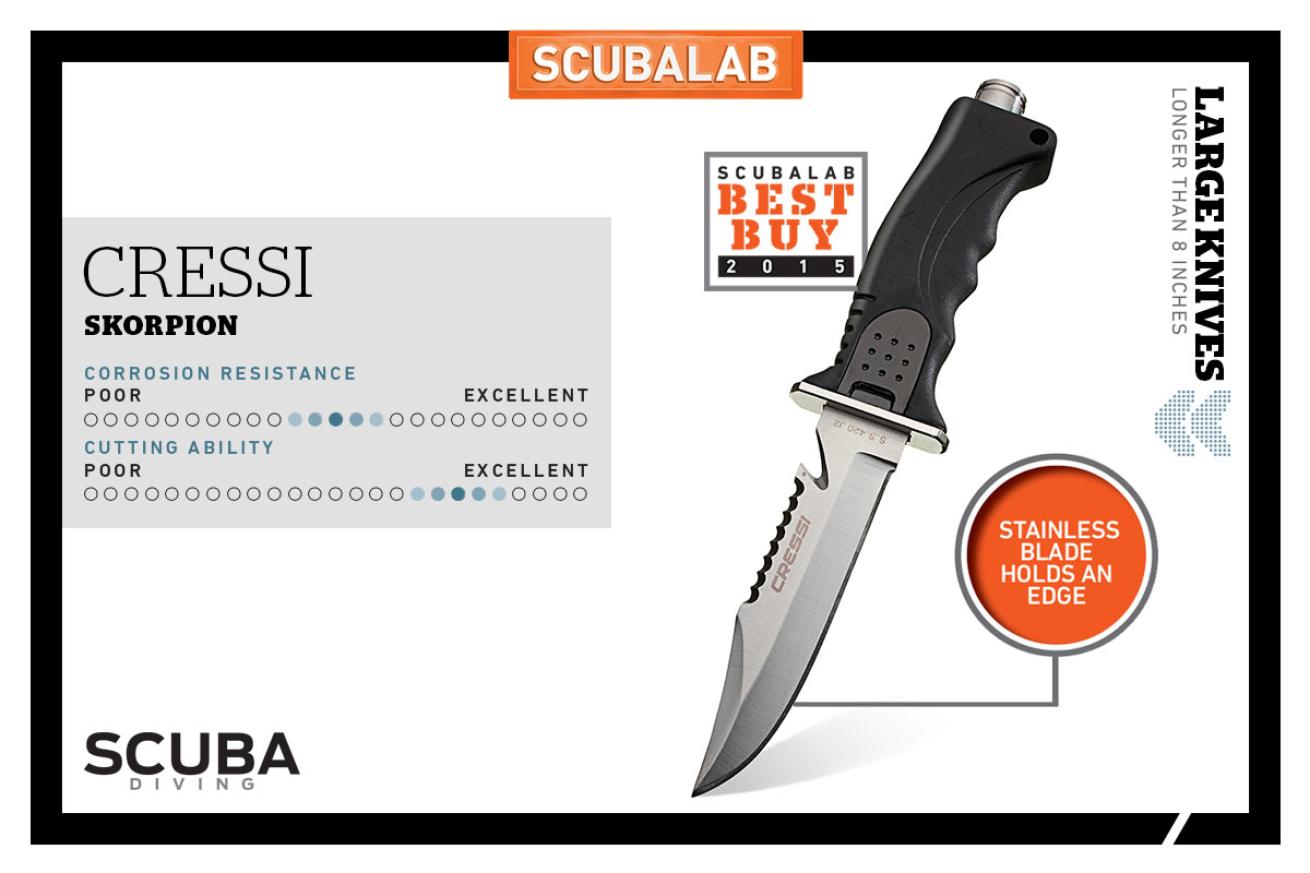
Michael KrausCressi: Skorpion
Looking very much like the little brother of the Borg, the Skorpion has a similarly thick blade and robust construction but on a more modest scale. Less than 9.5 inches overall, it has a smooth blade edge of more than 4 inches that performs comparably to the Borg. The handle, while a little thin in cross section, is well shaped and soft enough for a firm, comfortable grip, and the button-lock hard-plastic sheath does its job with no fuss (although on your calf the knife rattles in its sheath a little while kicking). The blade’s heavily serrated back edge saws aggressively, but its center-ground edge makes it tricky to sharpen. The 420 stainless blade holds a decent edge, but the handle isn’t removable, and you’ll need to rinse quickly and well after use in salt water. Capable, stoutly constructed and very attractively priced, the Cressi Skorpion is our Best Buy in the large-knife category.
$39.95; cressiusa.com
Aqua Lung: Argonaut Spartan
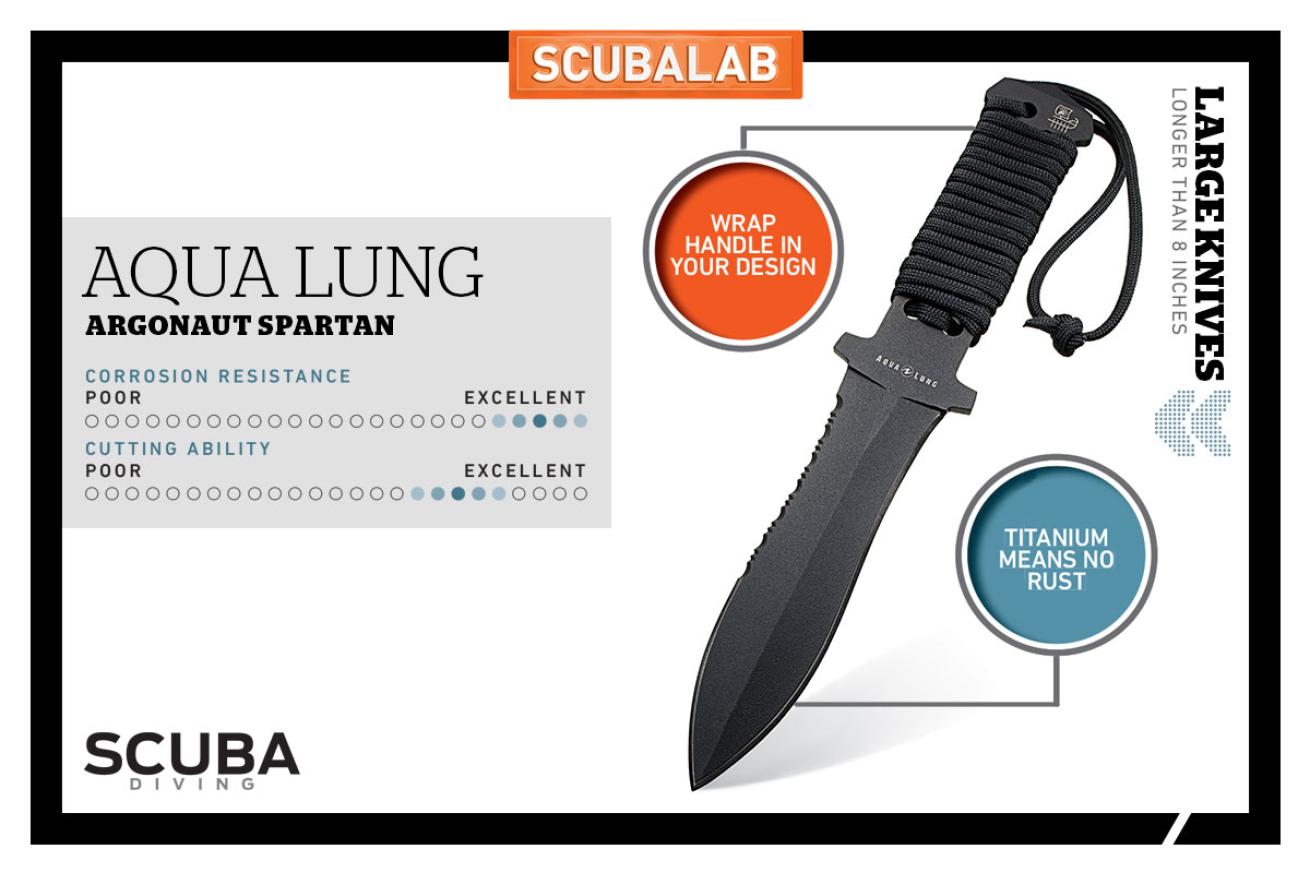
Michael KrausAqua Lung: Argonaut Spartan
Developed “with the world’s premier maritime commandos” and shaped from a single piece of 4 mm titanium, this is the sort of knife you might find wedged in the ribs of a Somali pirate. The handle comes wrapped with parachute cord that you can rewrap in your own design. The sheath is of hard Kydex (used in firearm holsters) thermoformed for a friction fit that grips the knife securely but allows you to draw it with a pull. The blade has serrated and smooth edges, which had a little trouble with heavy mono line but sliced easily through other test lines, even after dozens of cuts. We tested other knives that were more practical but none that could compare in sheer badassness.
$199 (also available in blunt style); $20 for neoprene leg strap; aqualung.com
Atomic Aquatics: TI6 Titanium
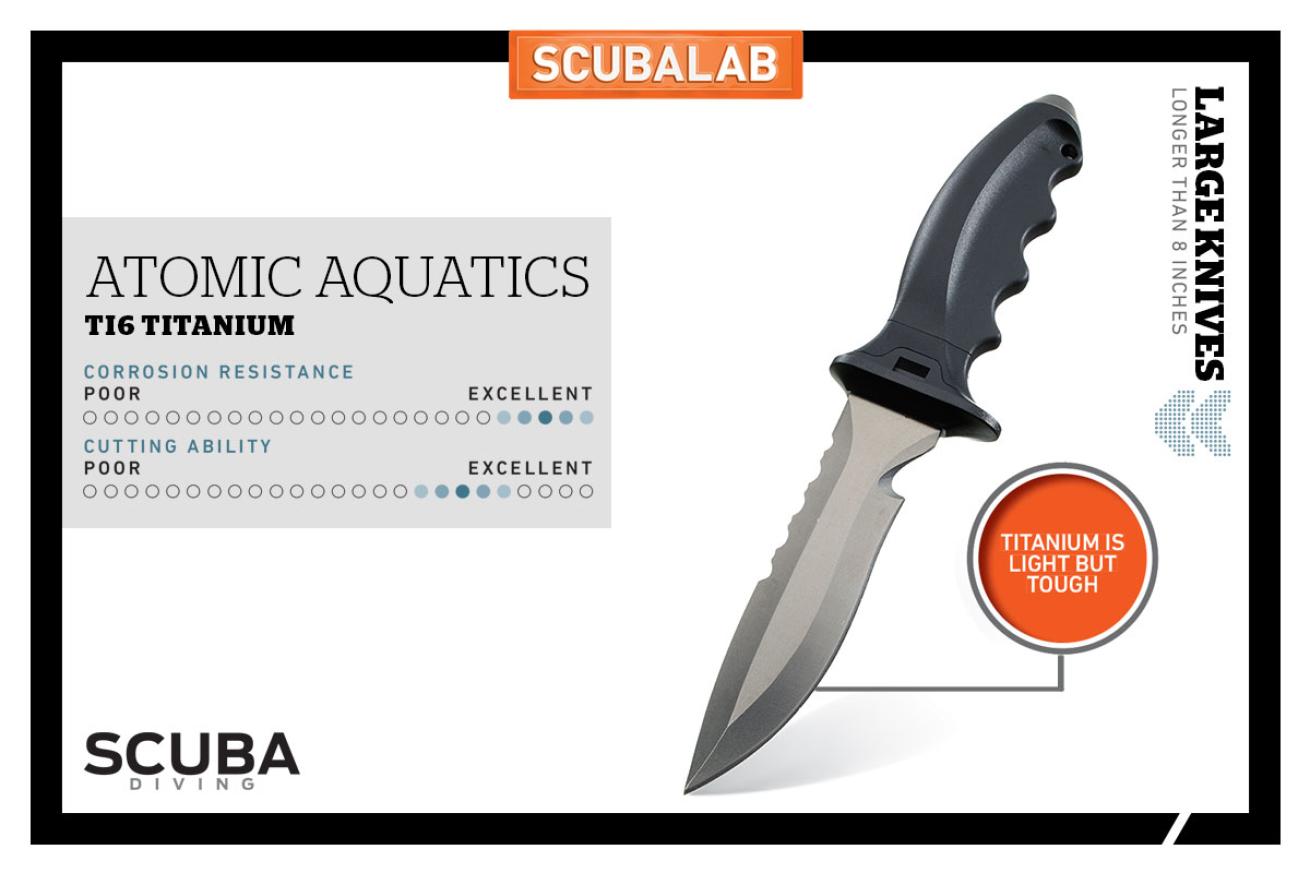
Michael KrausAtomic Aquatics: TI6 Titanium
Atomic achieved a nice balance with its Ti6 knife. The handle makes it feel like an extension of your hand; the blade puts both the smooth and heavily serrated cutting surfaces where they work well; and the sheath is excellent. Like other titanium blades we tested, it sometimes had a little trouble with thick mono but easily handled other lines. The titanium pommel unscrews so you can disassemble and clean the knife. While it’s very light (the sharp tip weighs 4 ounces), the Ti6 is pretty robust — although you won’t want to do any heavy prying with it. It’s an excellent choice for any diver who wants a full-size knife that won’t corrode and can do all-around service.
$129.98; available with blunt or sharp tip; atomicaquatics.com
Cressi: Borg
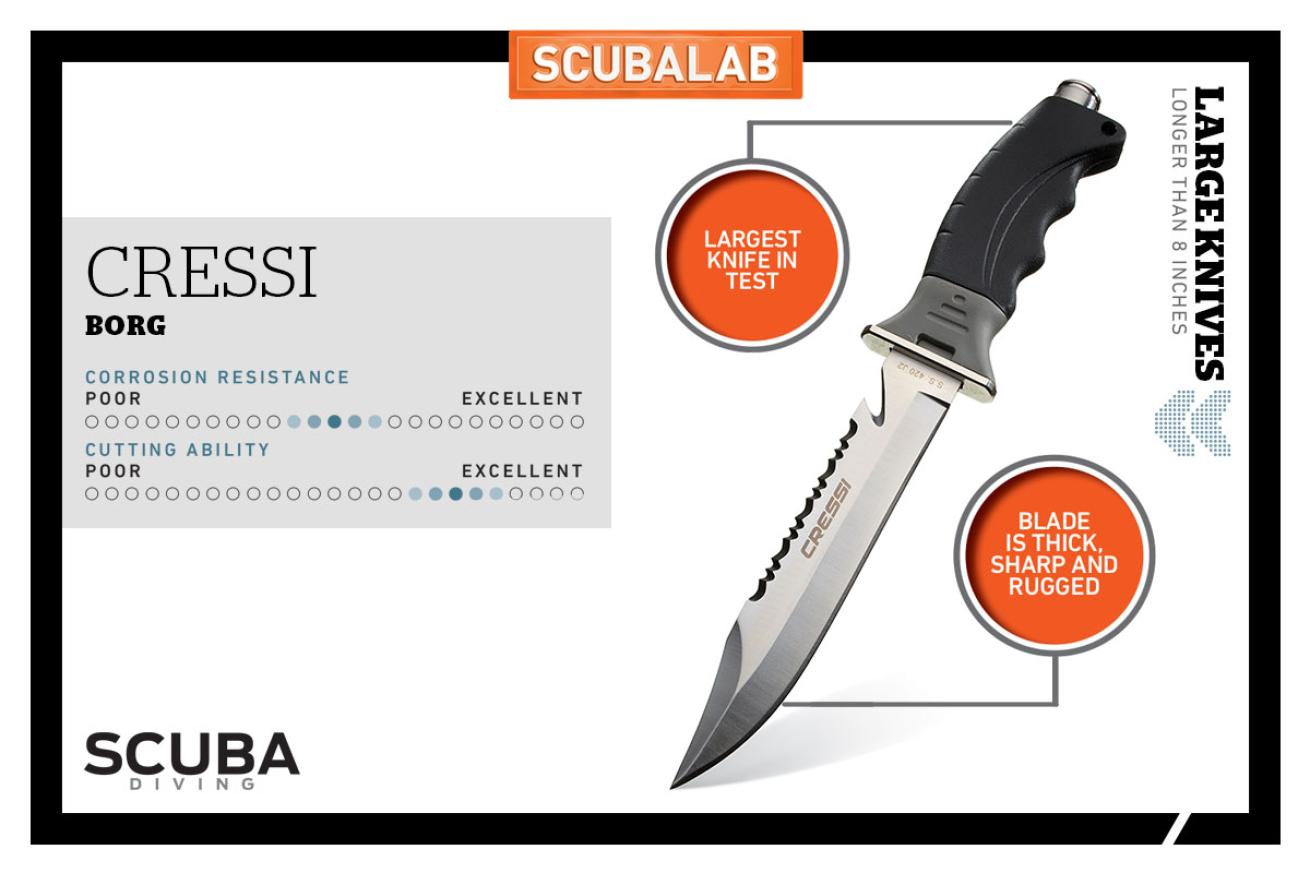
Michael KrausCressi: Borg
The Borg looks like a big knife. But pick it up and you’ll realize it’s actually a really big knife — 10.5 inches long, with the longest cutting edge of any knife we tested (5.5 inches). It’s heavily built, with a 3/16-inch-thick blade and a hammer pommel. All those beefy dimensions make the Borg robust enough to take in stride any abuse, from prying of hubcaps to crushing oysters. The stainless blade also cuts pretty well, breezing through our line tests while hesitating only on double cuts of heavy mono; it maintained a decent edge, even after many cuts. The hard-plastic sheath does a good job securing all this knife, releasing with a press of the lock, though you’ll need a longish calf to strap it onto.
$49.95; available with sharp or blunt tip; cressiusa.com
Mares: Force Plus
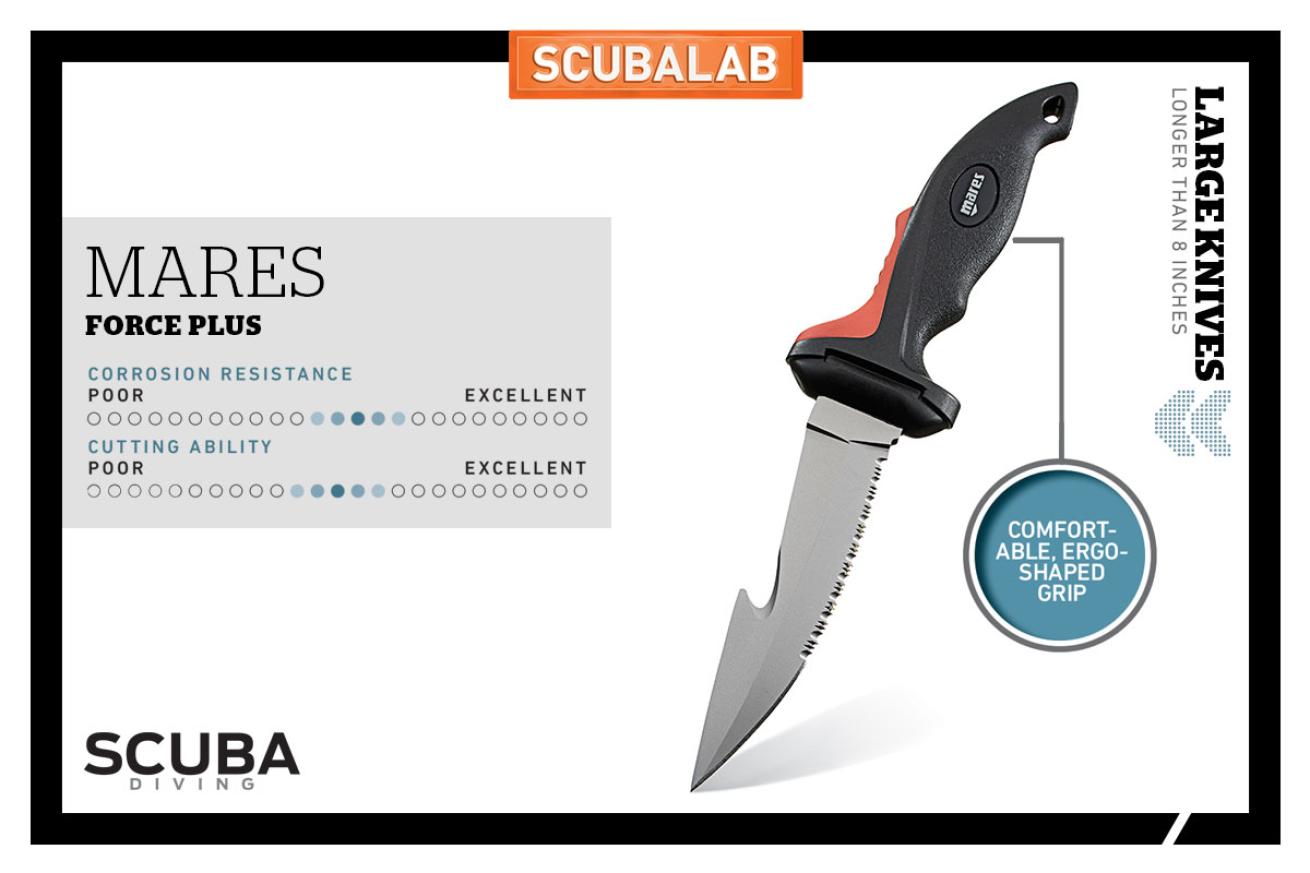
Michael KrausMares: Force Plus
The Force Plus has a handle with a bit of flair at the end that works with the rubbery thumb stop to provide a comfortable, secure grip. Made of coated stainless, the Force Plus has a drop-point blade with a cutting edge nearly 4 inches long that’s mostly serrated, with a smooth section near the tip. The aggressive serrations sawed through heavier lines well, but the blade, while very sharp, had trouble with heavy monofilament, which tended to bounce over the serrations. The sheath is excellent, with a smooth-operating, secure lock and a streamlined, nonsnagging profile. While the knife and sheath together are more than 9.5 inches long, the BC mount worked really well, keeping the knife out of the way but still within easy reach.
$65; mares.com
Riffe: Terminator
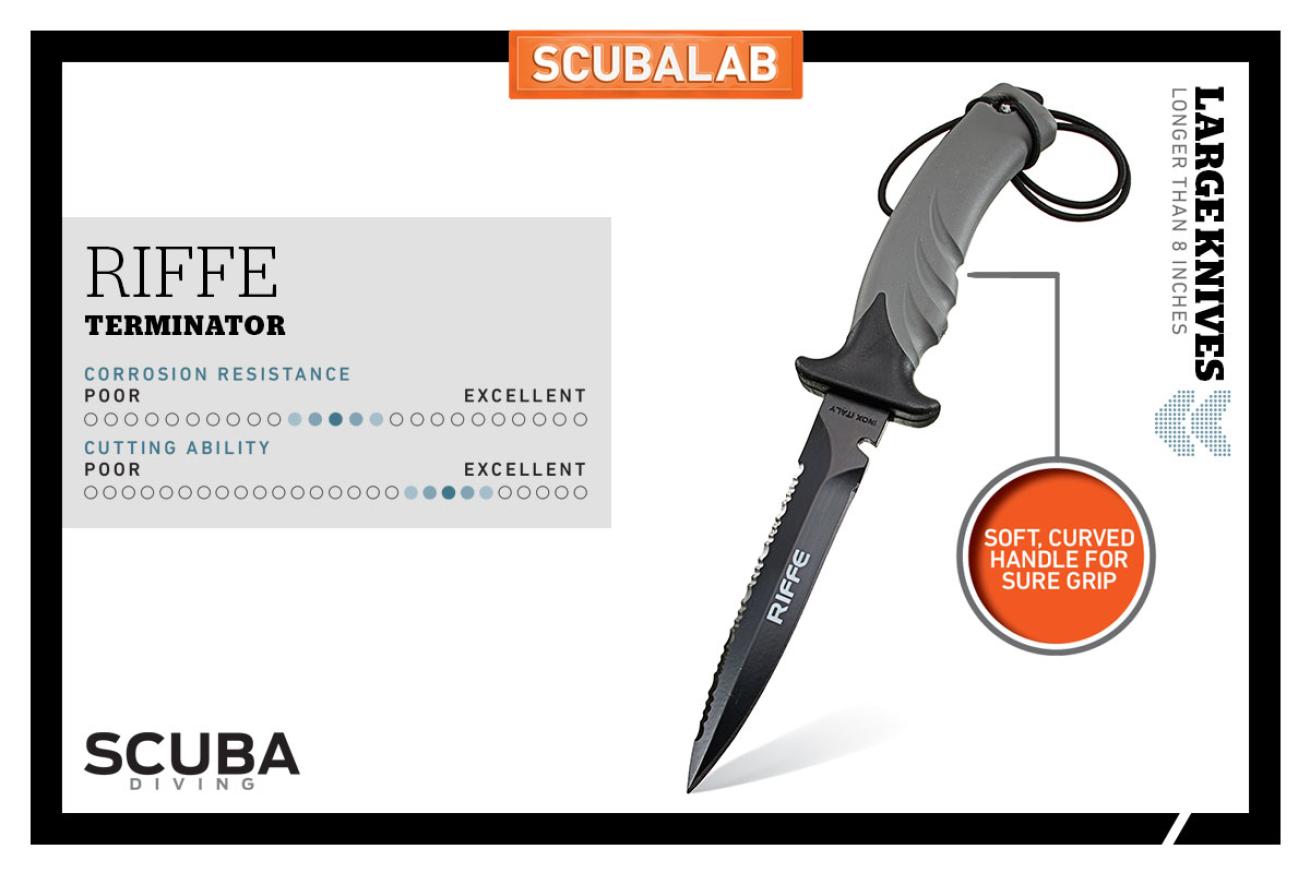
Michael KrausRiffe: Terminator
The Terminator was the most spearfishing-oriented knife we tested, with a lethal needle-point blade designed to quickly dispatch struggling fish. But it’s also suited for general dive use. Like most of our test knives, it worked a little getting through the heaviest monofilament test line, but it sliced easily through everything else, including a small steel cable (where it even maintained its edge surprisingly well). The over-molded soft-plastic handle provides a secure grip, and the knife secures to the sheath with both a self-locking friction lock and a bungee lanyard. The 420 stainless blade is Teflon coated to prevent corrosion, except along the sharpened bits, where it will rust if not rinsed thoroughly and oiled after use.
$82; speargun.com
Spyderco: Salt Assist
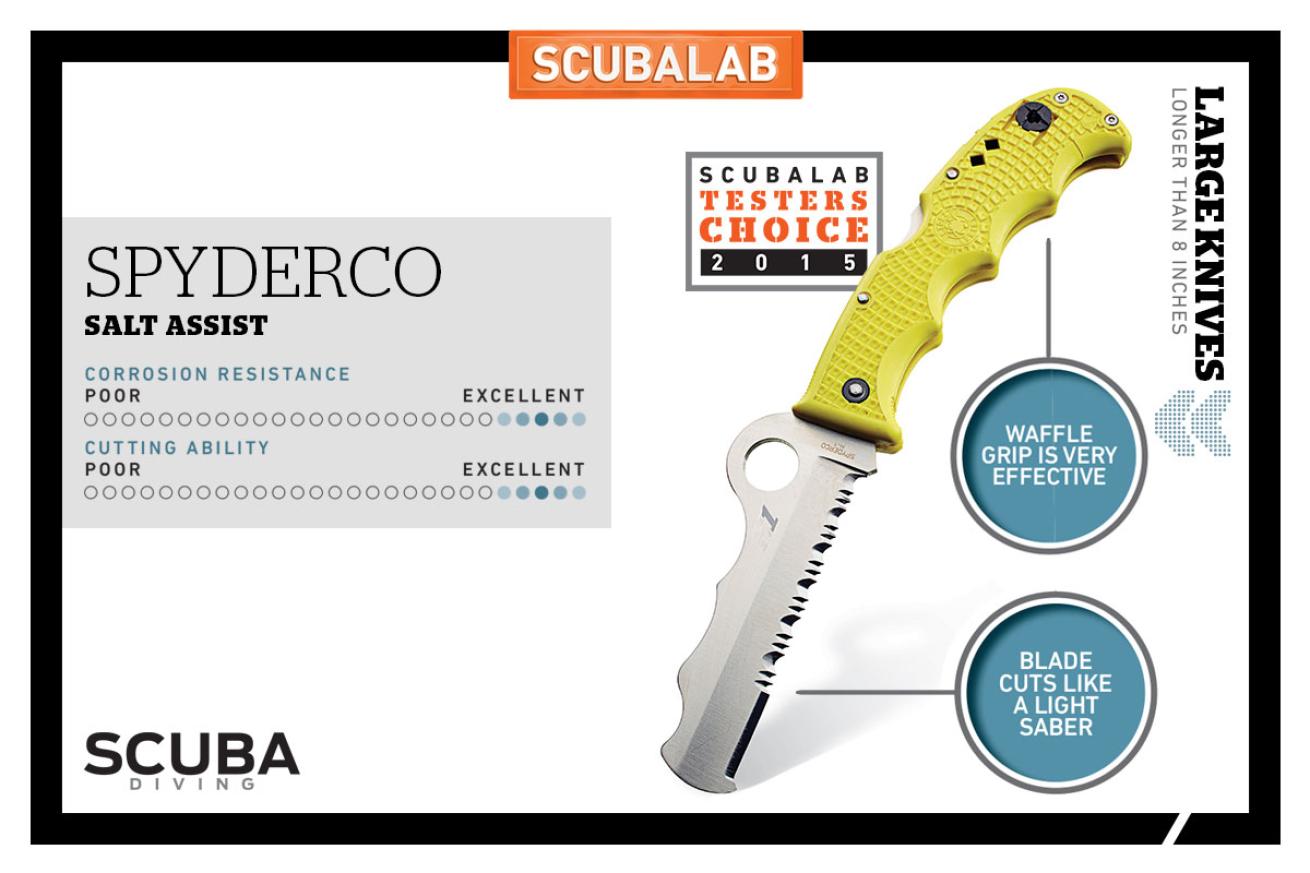
Michael KrausSpyderco: Salt Assist
The newest of Spyderco’s Salt line made of H-1 steel — which in our experience lives up to claims that it’s impervious to rust — is less than 5 inches long. It opens to 8.5 inches with a flick of the thumb (even with 5 mm gloves). The waffle grip is extremely effective, and the handle offers excellent control (although it might be a bit much for small hands). With a cutting edge 3.2 inches long, the blade sliced through all of our test lines like a light saber, and its rounded tip lets you slip the blade in between what you’re cutting and what you very much don’t want to cut. The handle has a carbide tip to break glass or ice, and a safety whistle. Sharp, safe, handy and rustproof, the Spyderco Salt Assist is our Testers Choice in the large-knife category.
$159.95; spyderco.com
Underwater Kinetics: Blue Tang Titanium Drop Point
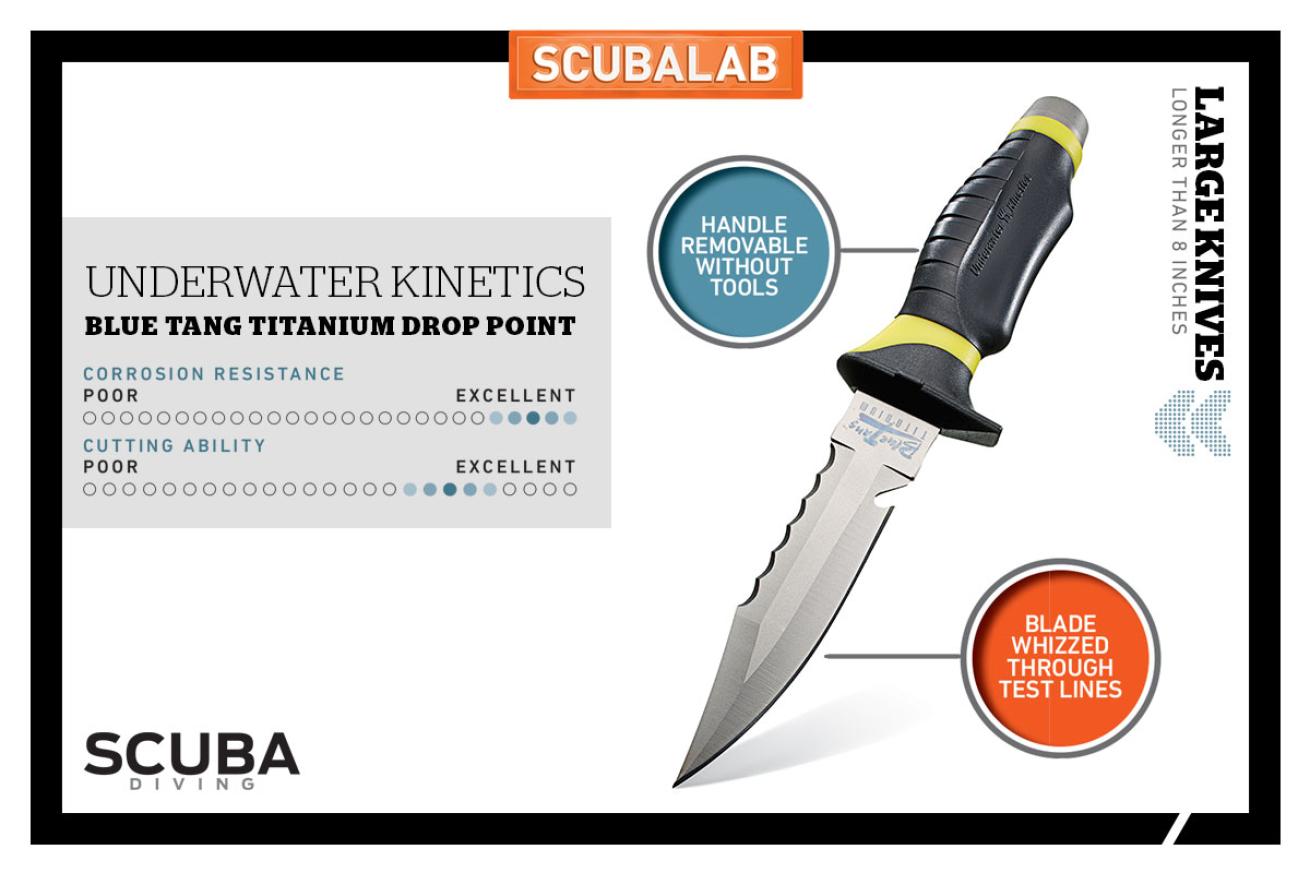
Michael KrausUnderwater Kinetics: Blue Tang Titanium Drop Point
Underwater Kinetics offers its Blue Tang with sharp or blunt tip, as well as in titanium or Hydralloy (a proprietary material that UK says has the strength of 420 stainless with corrosion resistance of 316 stainless; we soaked one in salt water for four days without any sign of corrosion). The pommel unscrews to disassemble the knife without any need for tools, the handle offers an excellent grip, and the sheath does its job well but can be a little tricky to unlock with bulky gloves. It sometimes needed two passes to cut our heavy plastic line, but it whizzed through all the other test lines, and kept an edge after many cuts.
$121.99; Hydralloy steel version $58.99; uwkinetics.com
XS Scuba: Fogcutter X
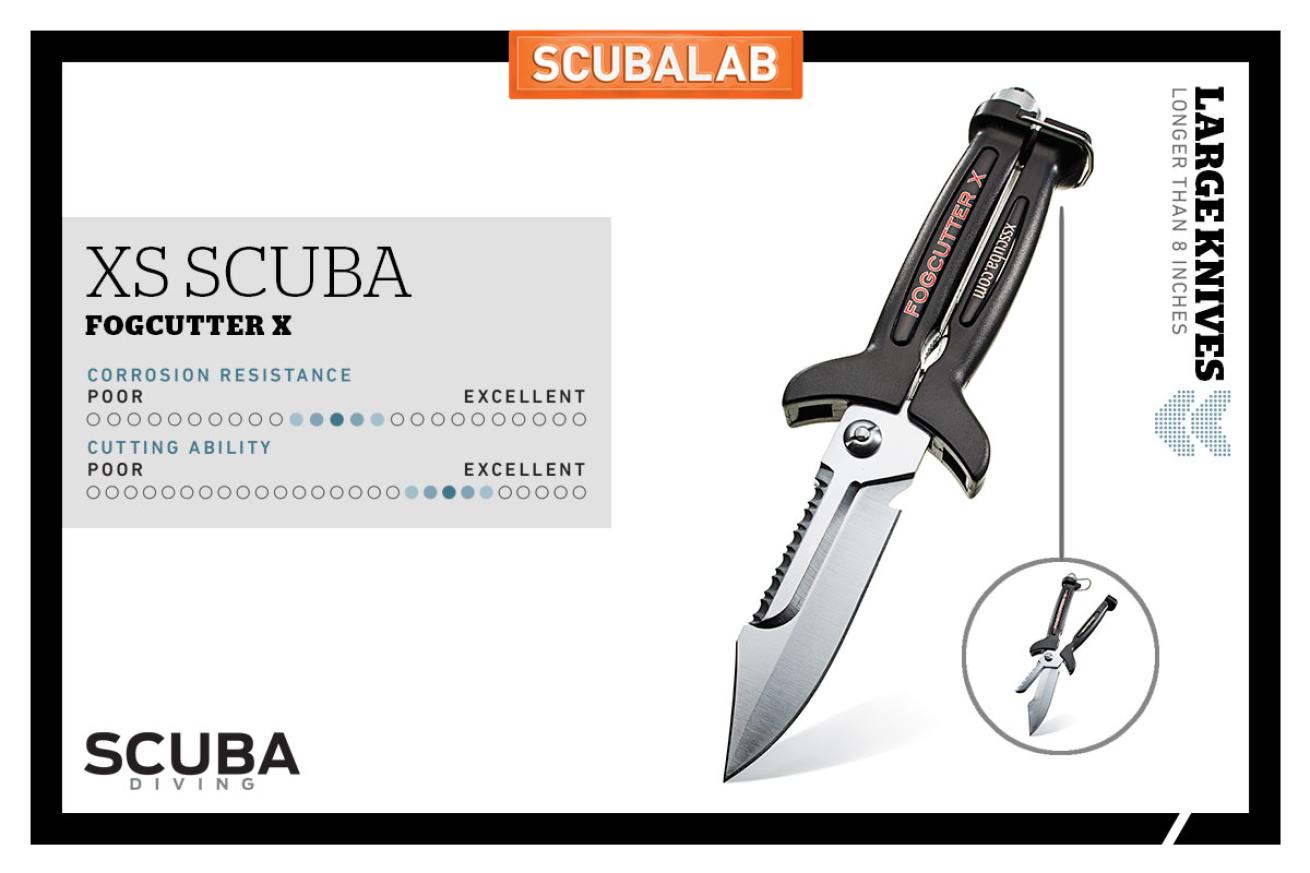
Michael KrausXS Scuba: Fogcutter X
Looking something like a genetic experiment with a dive knife and a pair of garden shears, the Fogcutter X does a lot of stuff, some of it very well. Closed, it looks like a traditional dive knife, but unlocked the handle and blade split into a pair of shears that will make short work of just about anything you can fit inside its jaws. It performed well as a knife but even better as shears; the only downside is that when you’re snipping there are lots of sharp edges moving around — you’d have a hard time safely using the shears close to stuff you didn’t want cut — and the 420 stainless requires thorough rinsing and lubricating after use. But this is a very capable all-around tool.
$85; xsscuba.com
Cressi: Alligator Knife and Scissors
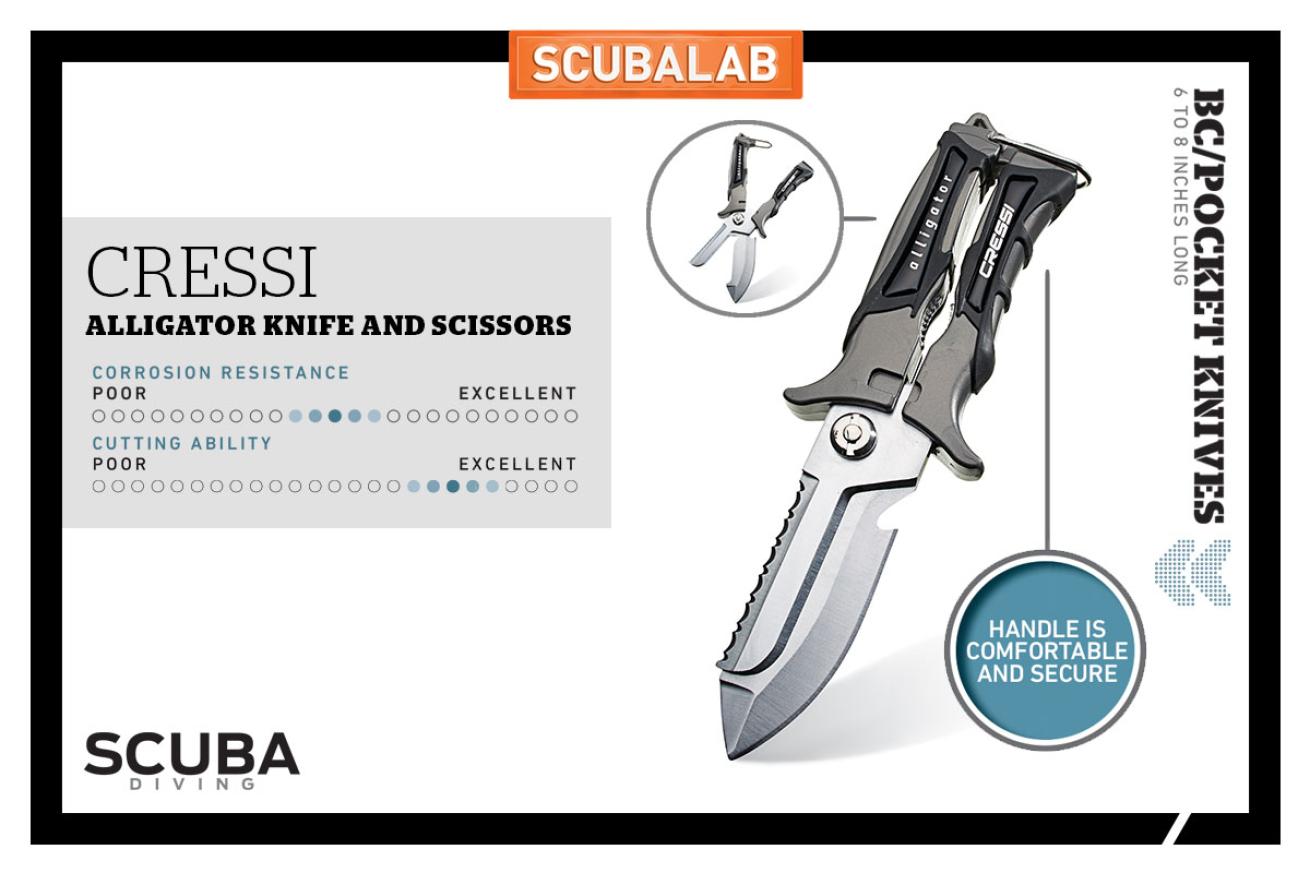
Michael KrausCressi: Alligator Knife and Scissors
Just 6.5 inches long overall, this combination knife/ scissors tool is small enough to attach unobtrusively on a BC hose or straps (mounts are included for both). When closed, the blade has a conventional profile, with a 3-inch smooth edge and a serrated section on the back. Unlock the handle, and the blade splits into spring-loaded scissors that will chop through pretty much anything you can get them around. The handle is only 3 inches long, but the rubber insets and the wide guards provide a firm grip, keeping your fingers away from the sharp working parts. The sheath keeps it securely in place, and unlocks easily, even with gloves. The 420 stainless steel holds an edge well, but it will require thorough rinsing and oiling to stay shiny.
$74.95; cressiusa.com
Seac Sub: Rip Race
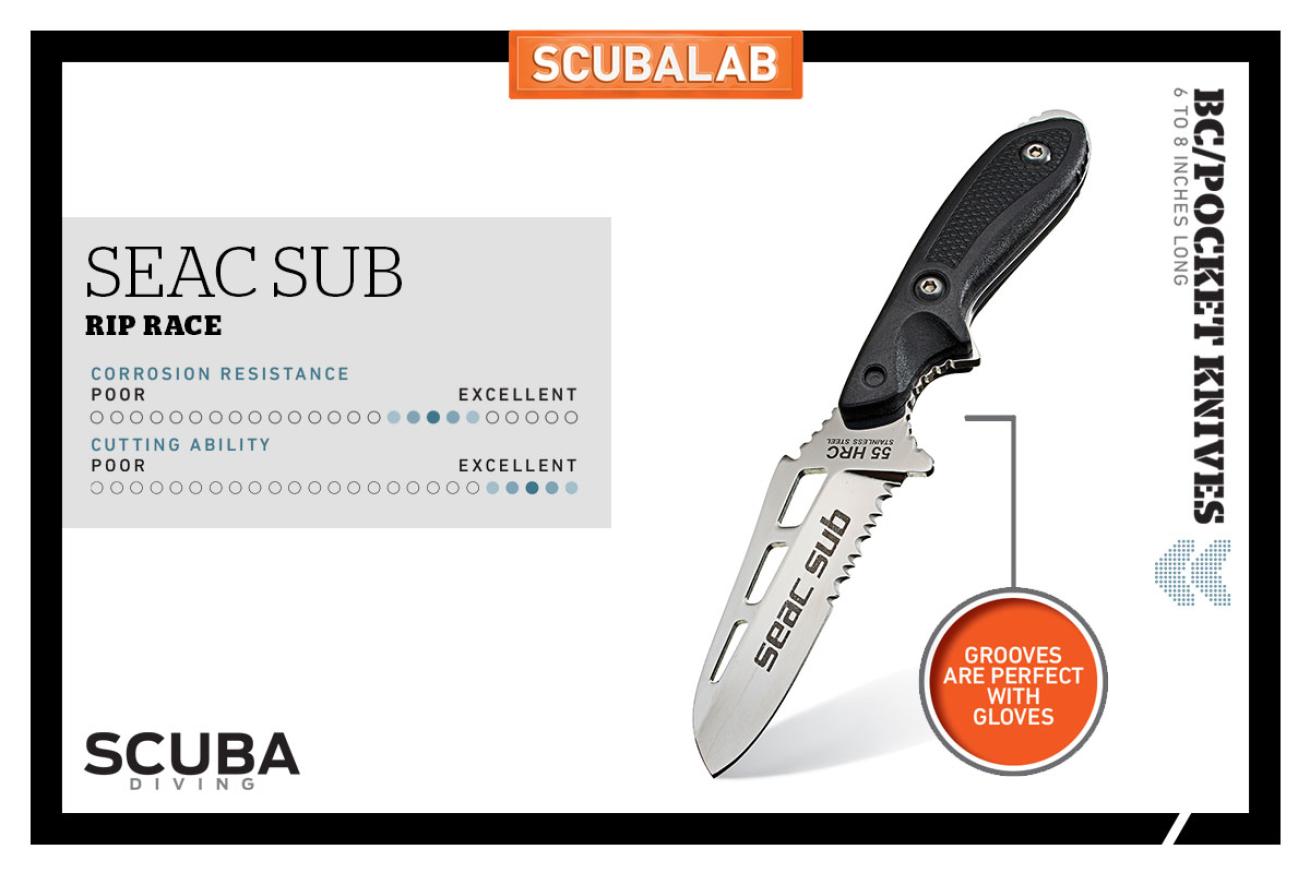
Michael KrausSeac Sub: Rip Race
With its steep, bright, drop-point blade, the Rip Race is one of two Seac knives we tested (read the review of the Rip Tek). Aside from blade configuration, the knives are virtually identical — shaped from thick stainless with a 3-inch edge that was a top performer in all cutting tests, and a composite handle that unscrews (with the included Allen wrench) for cleaning. The grip shape is excellent, and the thumb and forefinger grooves are perfect with gloves, though a little aggressive when barehanded. The sheath has good BC mounts and a very secure thumb release, but the knife fits in the sheath in only one direction, making left-handed operation a little tricky.
$97; seacsub.com
Underwater Kinetics: Remora Titanium Blunt Tip
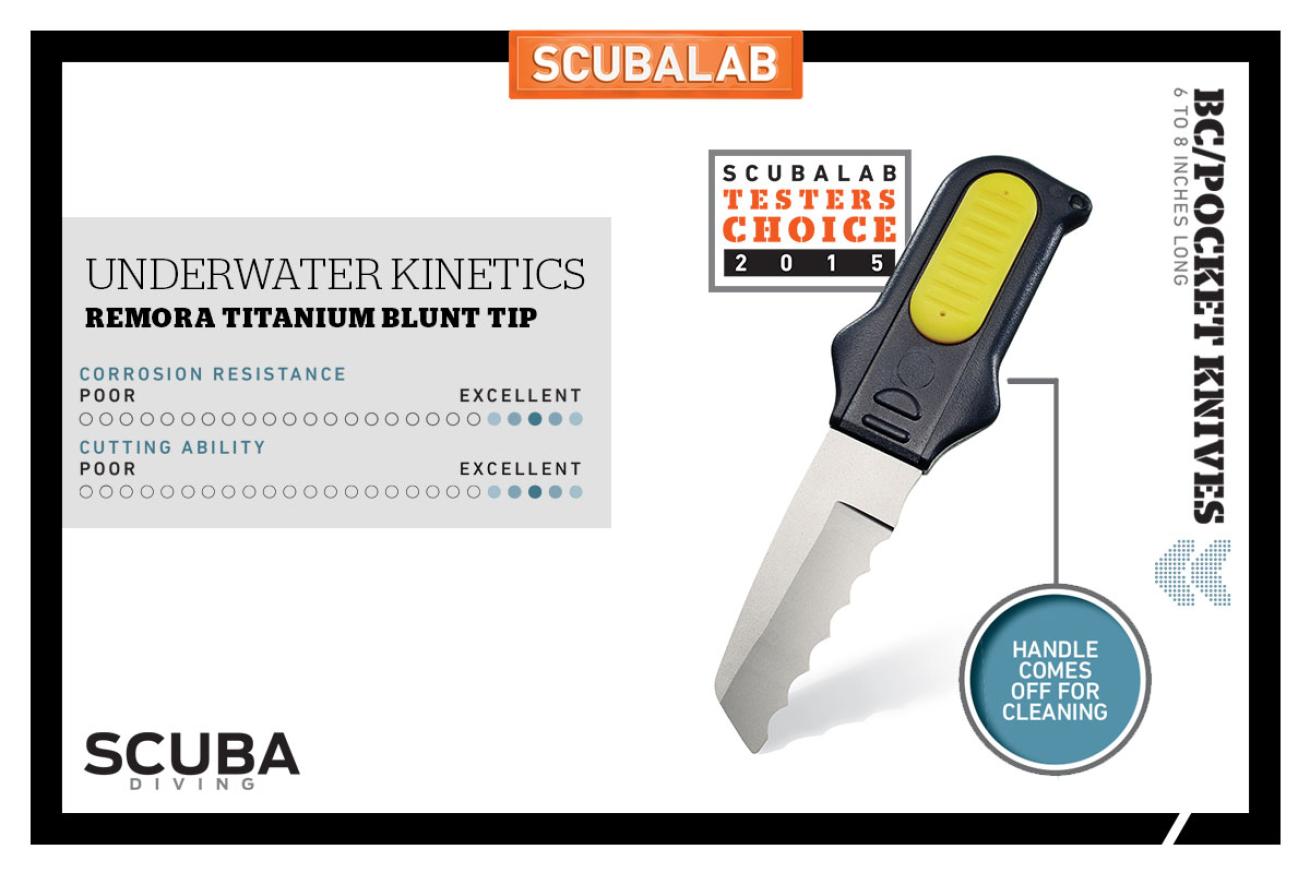
Michael KrausUnderwater Kinetics: Remora Titanium Blunt Tip
The deeply serrated edge of the Remora is less than 2.5 inches long, but it cut like a demon through all the materials we tested. As you’d expect for such a small knife — only 6.5 inches overall — the handle is also on the small side, and the grip is decidedly better barehanded. The 1/8-inch-thick blade will take a lot of abuse and pry- ing, and the rounded tip lets it slip in for delicate cuts. The inserts pop out of the handle to remove the blade for cleaning, and the friction-lock sheath is compact and includes excellent BC mounts for hose or strap. The Remora in Hydralloy steel was also one of our top performers. The Remora Titanium is our Testers Choice in the BC/pocket knives category.
$113.99; Hydralloy stainless $52.99; uwkinetics.com
XS Scuba: Mini Fogcutter
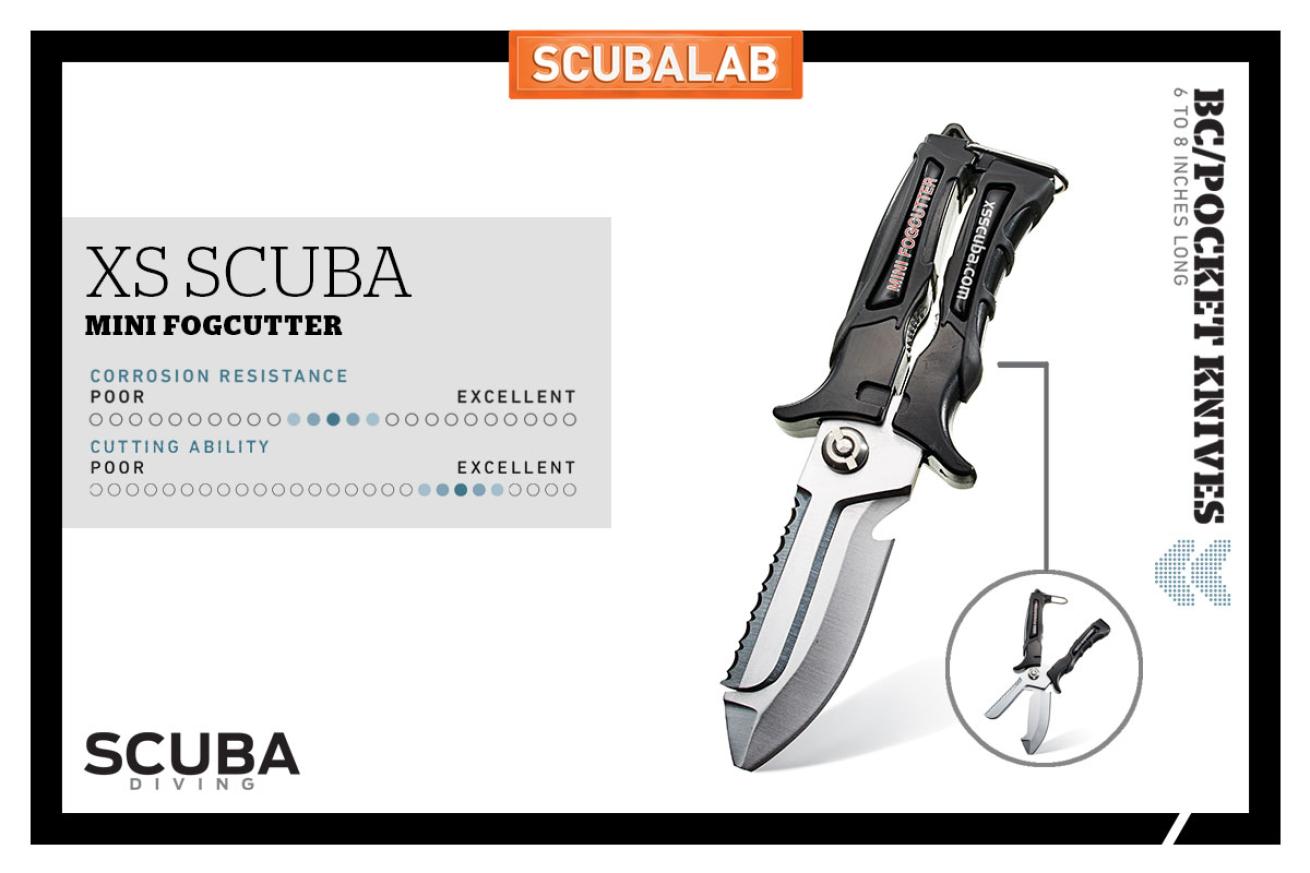
Michael KrausXS Scuba: Mini Fogcutter
The little brother to the Fogcutter X, the Mini Fogcutter also bears a family resemblance to the Cressi Alligator and Scissors, but with a blunted blade tip. Whether using it as a knife or scissors, the Mini Fogcutter sliced quickly through everything we put it up against. It shares the pros and cons of the other tools of this design we tested — the versatility to slice, cut, chop, saw and grip, and the need for caution with all the sharp parts levering around while doing it. The sheath has an excellent lock and release, and very good BC mounts, and the grip and handle lock are very good. Made of 420 stainless steel, the blades hold an edge but are subject to corrosion unless well rinsed and oiled.
$75; xsscuba.com
Scubapro: X-Cut Titanium
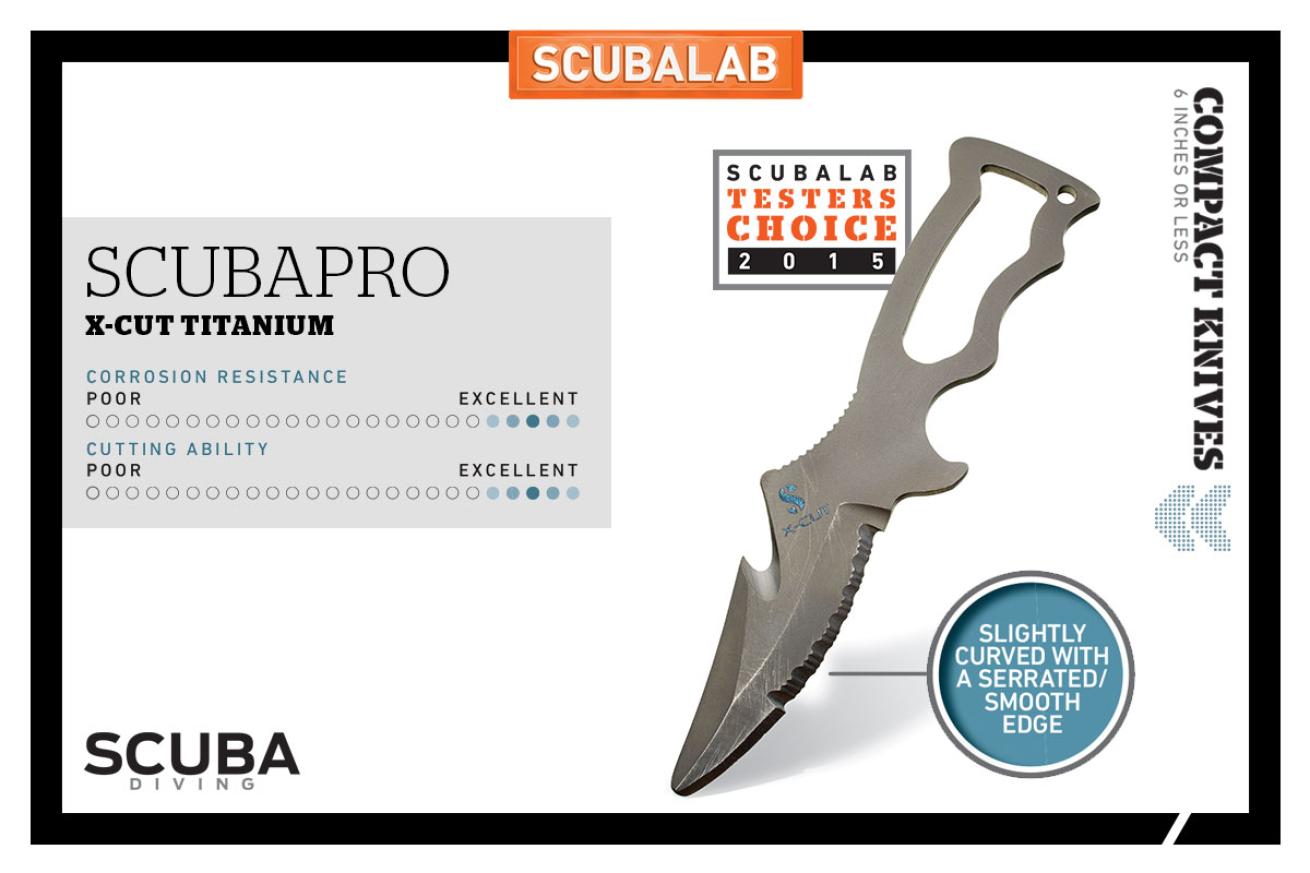
Michael KrausScubapro: X-Cut Titanium
Made from a single block of titanium, the X-Cut is just 5.6 inches in length and 1/8-inch thick. But it has a big bite, with the 2.5-inch blade cutting with surprising ease through everything from heavy plastic line to braided nylon. The blade’s design — slightly curved with serrated and smooth edges — makes the most of a short cutting surface. The handle is none too big and a little hard on bare hands for difficult cuts, but the forefinger guard and grooved thumb grip help maintain a steady hold. The soft sheath (with a belt loop) makes the most of the X-Cut’s compact size (the hook-and-loop locking tab must be closed carefully to keep the knife securely in place). The X-Cut Titanium was our Testers Choice in the compact-knife category.
$80; scubapro.com
Mares: Hero
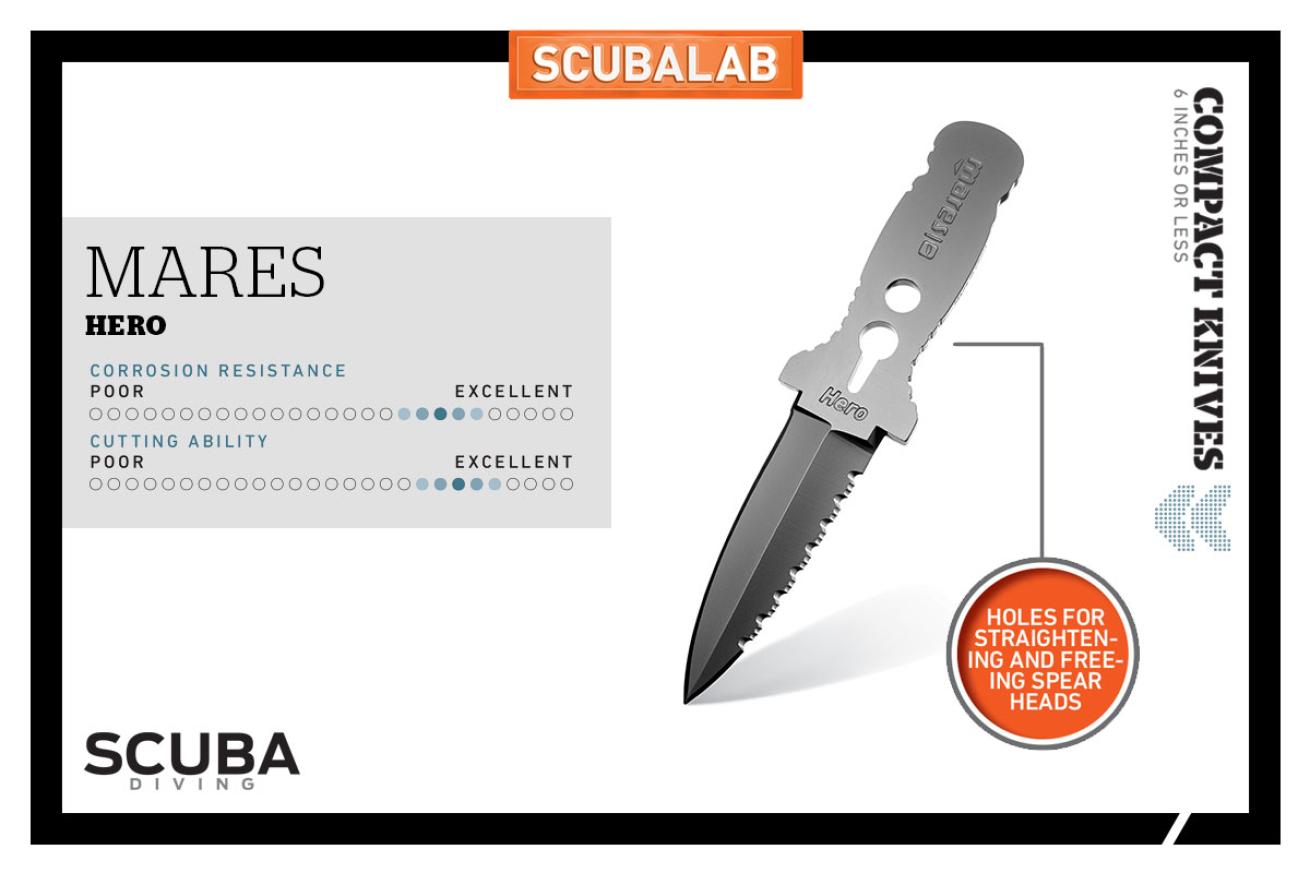
Michael KrausMares: Hero
For a knife just a hair over 5 inches, the Hero sliced through even our thickest lines with only an occasional second pass for heavy plastic line. Made of coated 440A stainless known more for corrosion resistance than edge holding, the spear-point blade held its edge through many repetitive cuts. The all-metal design (with holes for straightening and freeing spear heads) means there’s no handle or hardware for salt to hide under. The short handle makes the grip tricky for re- ally hard cuts, but it’s shaped and grooved to make the best of its small size. The Hero secures with a tabbed O-ring to the soft sheath, which has two belt loops, and comes with elastic bands for mounting to your calf or arm.
Dive Rite: Line Cutter
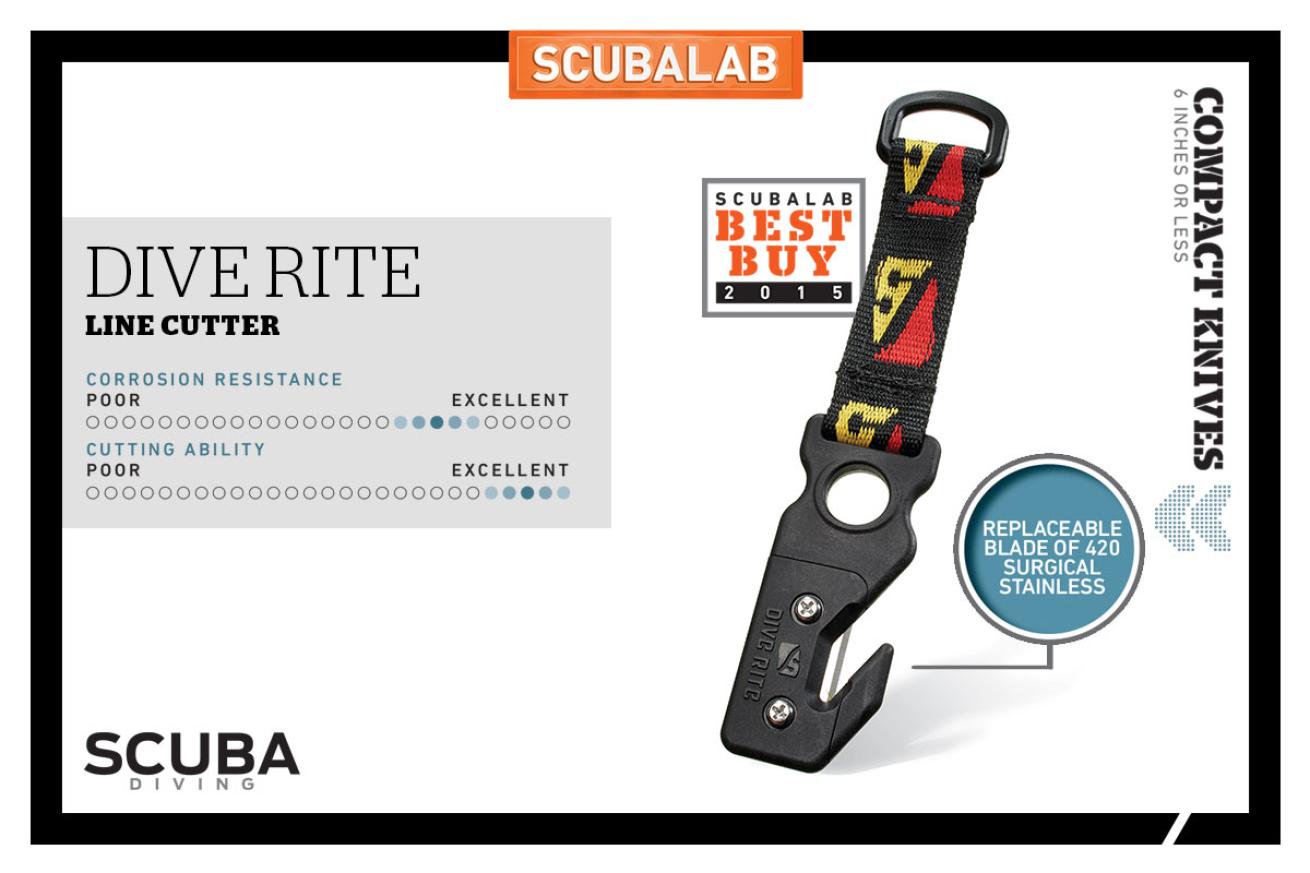
Michael KrausDive Rite: Line Cutter
The least knifelike tool we tested, the Line Cutter turned out to be one of our favorites. Stowed in its sheath (with excellent mounts), it’s secure and out of the way, but it deploys with a yank of the strap handle. The blade guard makes it almost impossible to cut anything unintentionally. But when you mean to, the replaceable blade of 420 surgical stainless made short work of even doubled heavy plastic line. It cut with ease through everything we could fit into its jaws, up to about 3/8-inch, which is really its only limitation. You won’t cut 3/4-inch line with it, or do any sawing or prying. But it does what it does with near perfection. The Dive Rite Line Cutter is our compact-knife Best Buy.
$24; diverite.com
Mares: Force Nano Plus
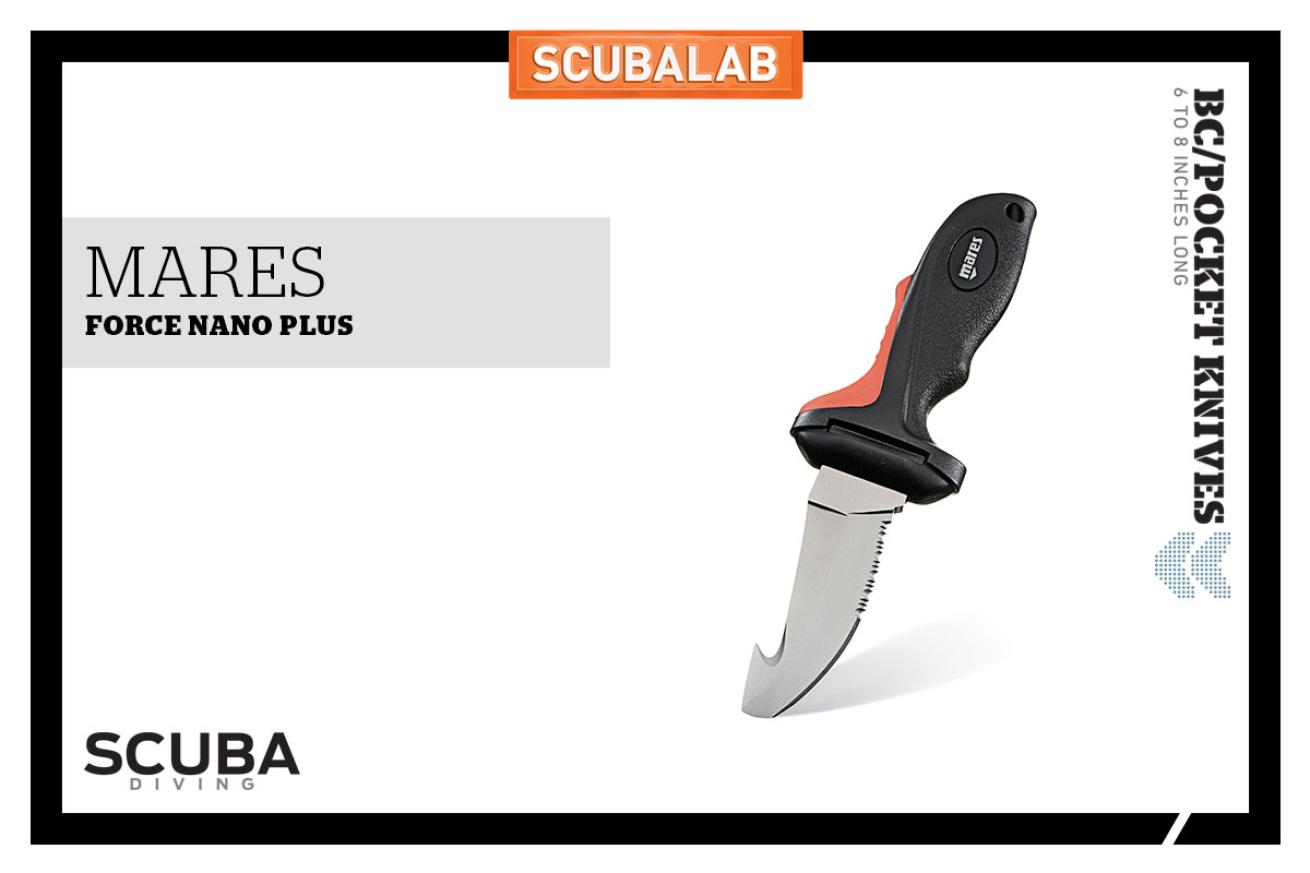
Michael KrausMares: Force Nano Plus
Only 6.5 inches long, it has a PVD- coated stainless blade that cut pretty well considering it’s less than 2.5 inches long. The line cutter was effective for monofilament, but it requires care when making hard cuts. The grip is good, and the BC mounts are excellent.
$65; mares.com
XS Scuba: Rook
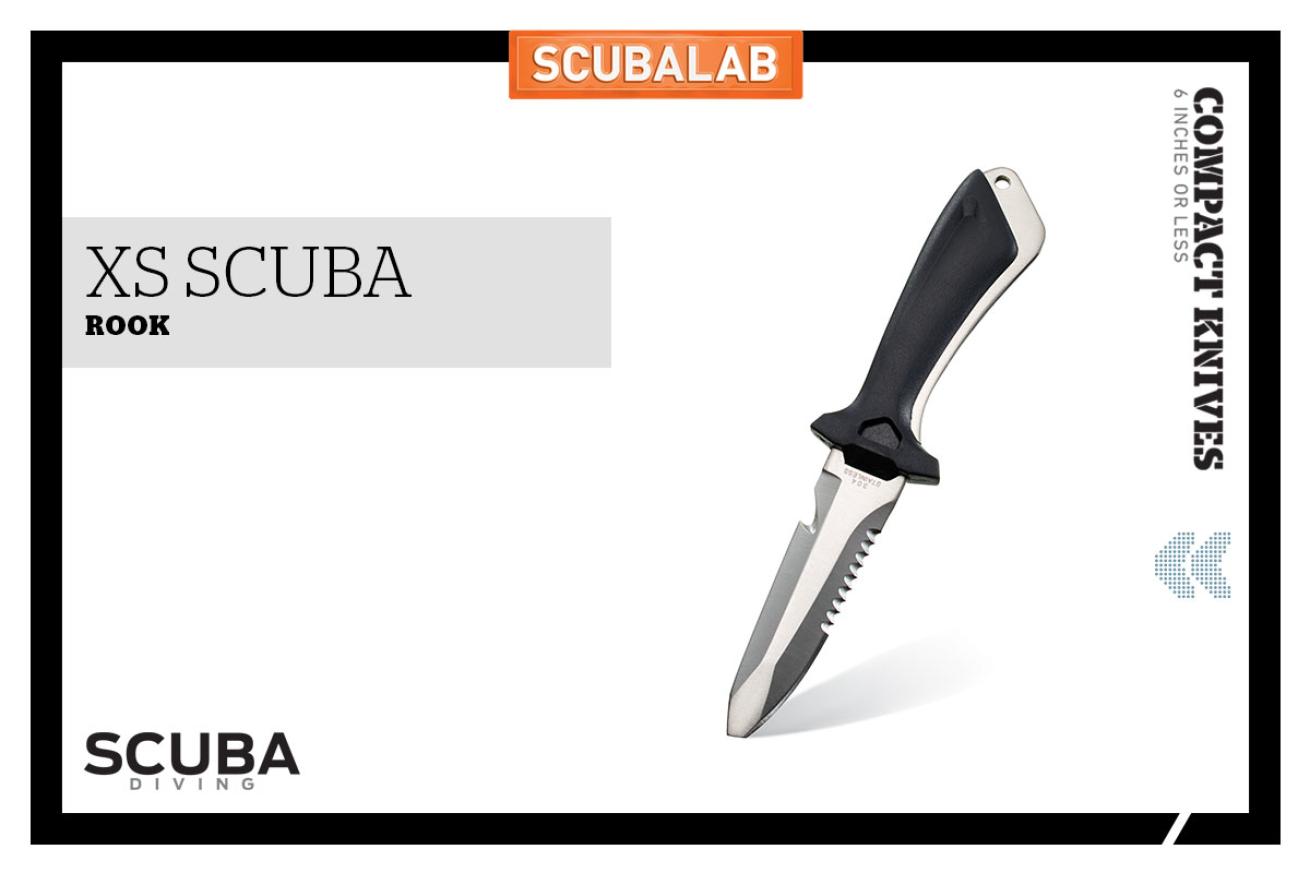
Michael KrausXS Scuba: Rook
The grip on the Rook is comfortable for such a small knife (a hair over 6 inches), and the sheath is secure and easy to release. Made of 304 stainless, this is a rugged, all-around tool that can stand even some sawing or prying, though it needs careful rinsing and oiling to keep corrosion at bay.
$48; xsscuba.com
Cressi: Victory
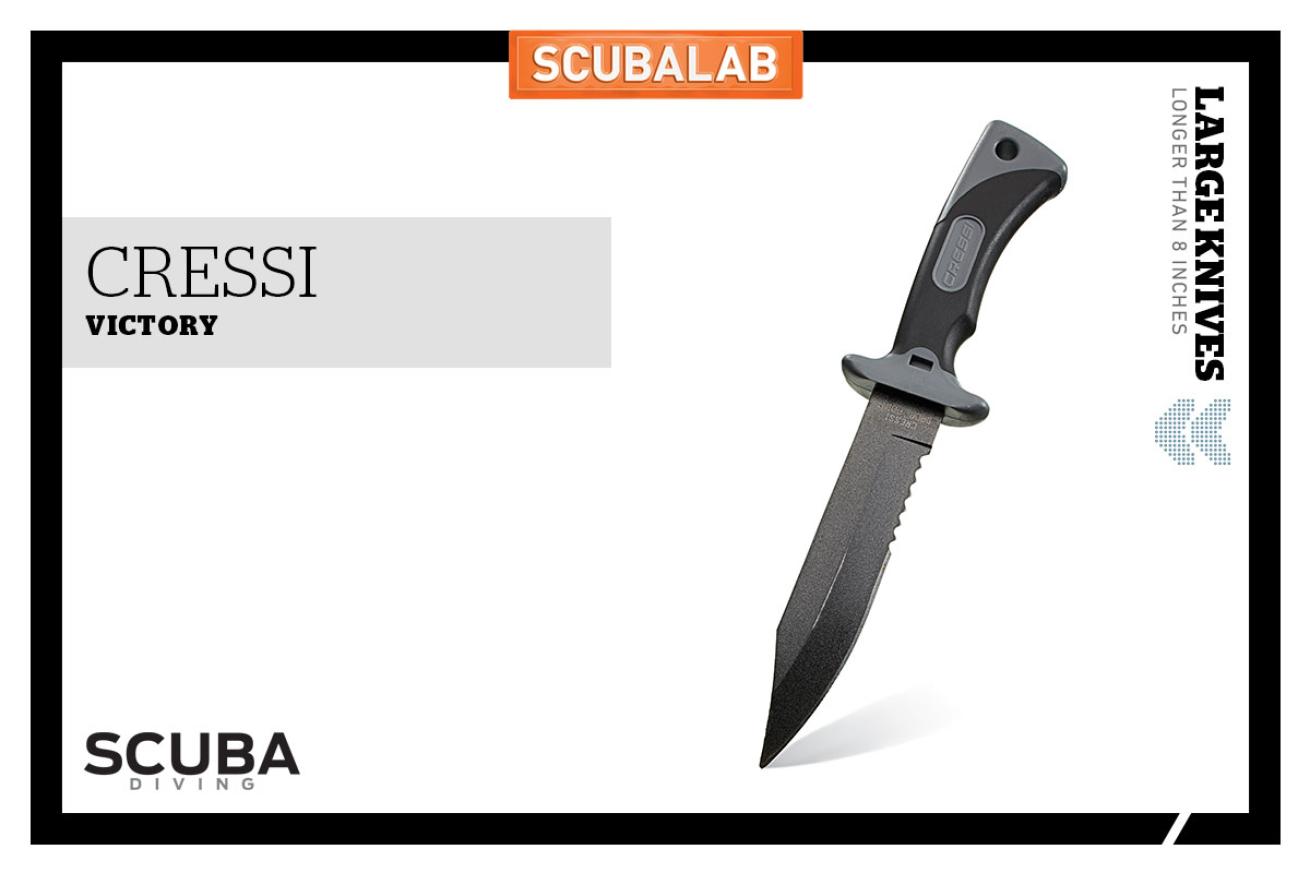
Michael KrausCressi: Victory
With its thick blade of diamond-coated 420 stainless, the 9.4-inch Victory can take lots of abuse. The blade cut well and held a decent edge after many repetitive cuts. The plastic/rubber handle has wide guards, and the push-lock sheath worked very well.
$54.95; cressiusa.com
Mares: Iago
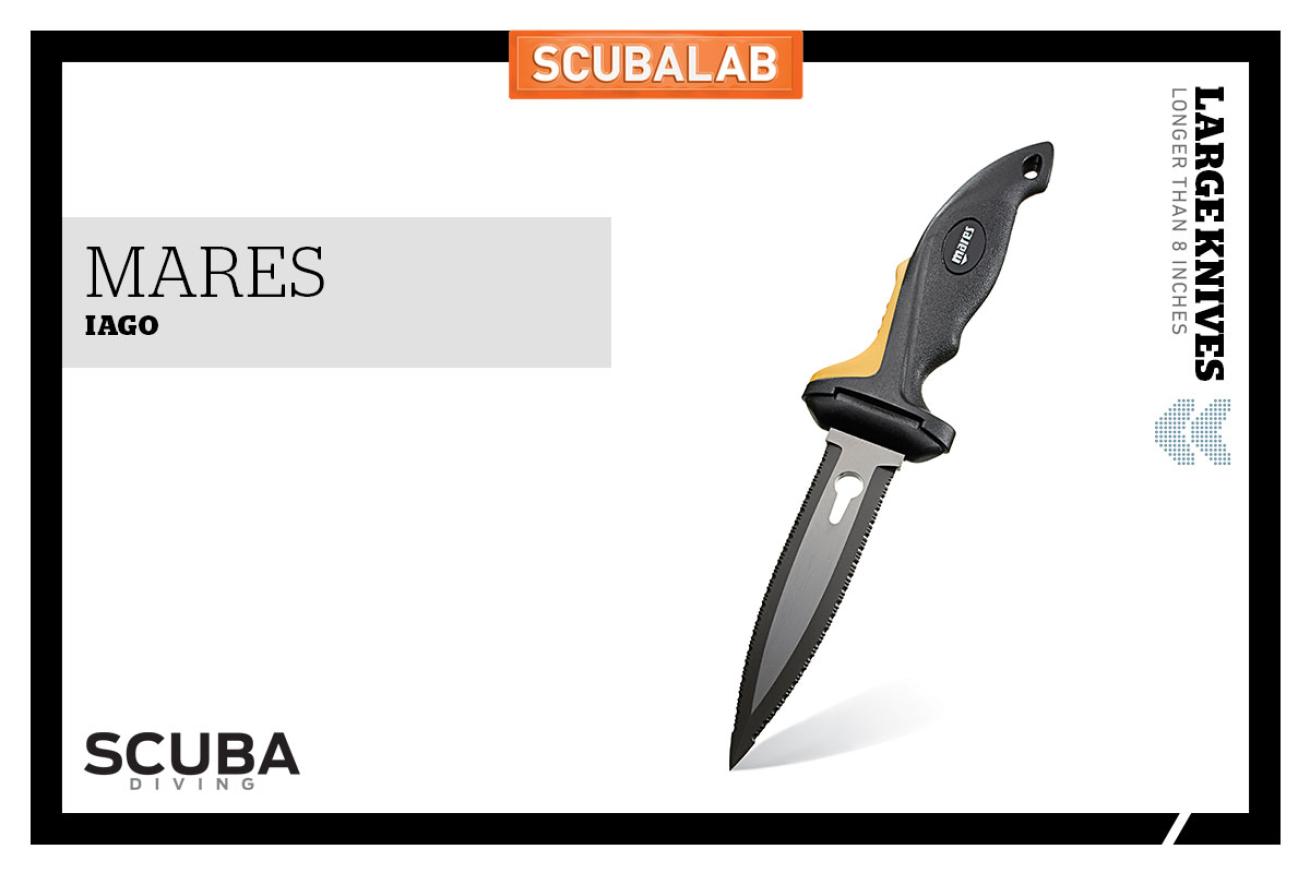
Michael KrausMares: Iago
The Iago’s needle-point blade would no doubt make short work of a speared fish, but it worked pretty hard getting through the lines we tested. The handle is very comfortable and rock solid, with a curved base that’s a soft rubbery material that falls naturally into your hand.
$65; mares.com
Underwater Kinetics: Fusilier Hydralloy Blunt Tip
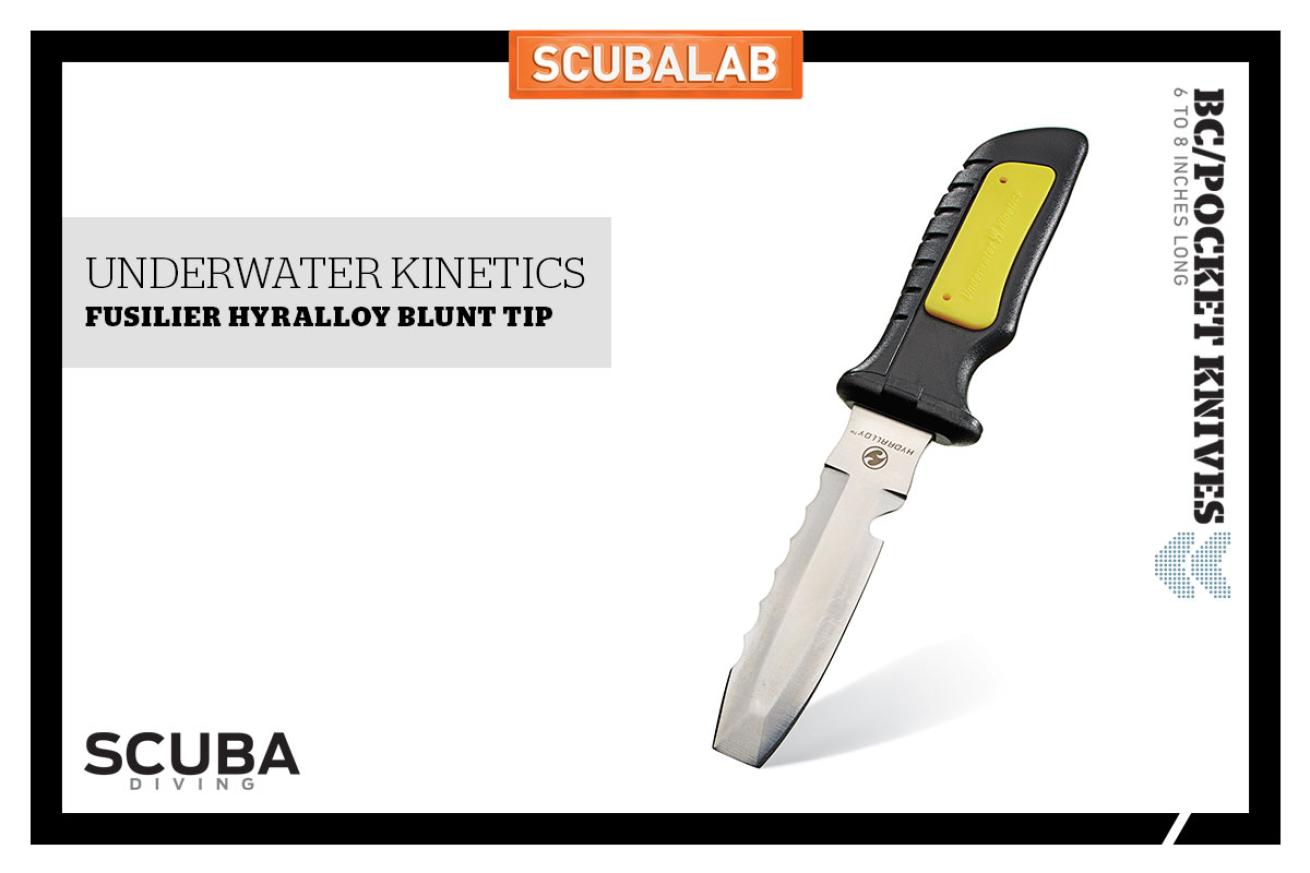
Michael KrausUnderwater Kinetics: Fusilier Hydralloy Blunt Tip
At 7.9 inches, the Fusilier is between the Blue Tang and Remora, but it shares features with both. The handle is removable without tools and has no metal-to-metal contact, and the blade performed very well.
$65.99; uwkinetics.com
Seac Sub: Rip Tek
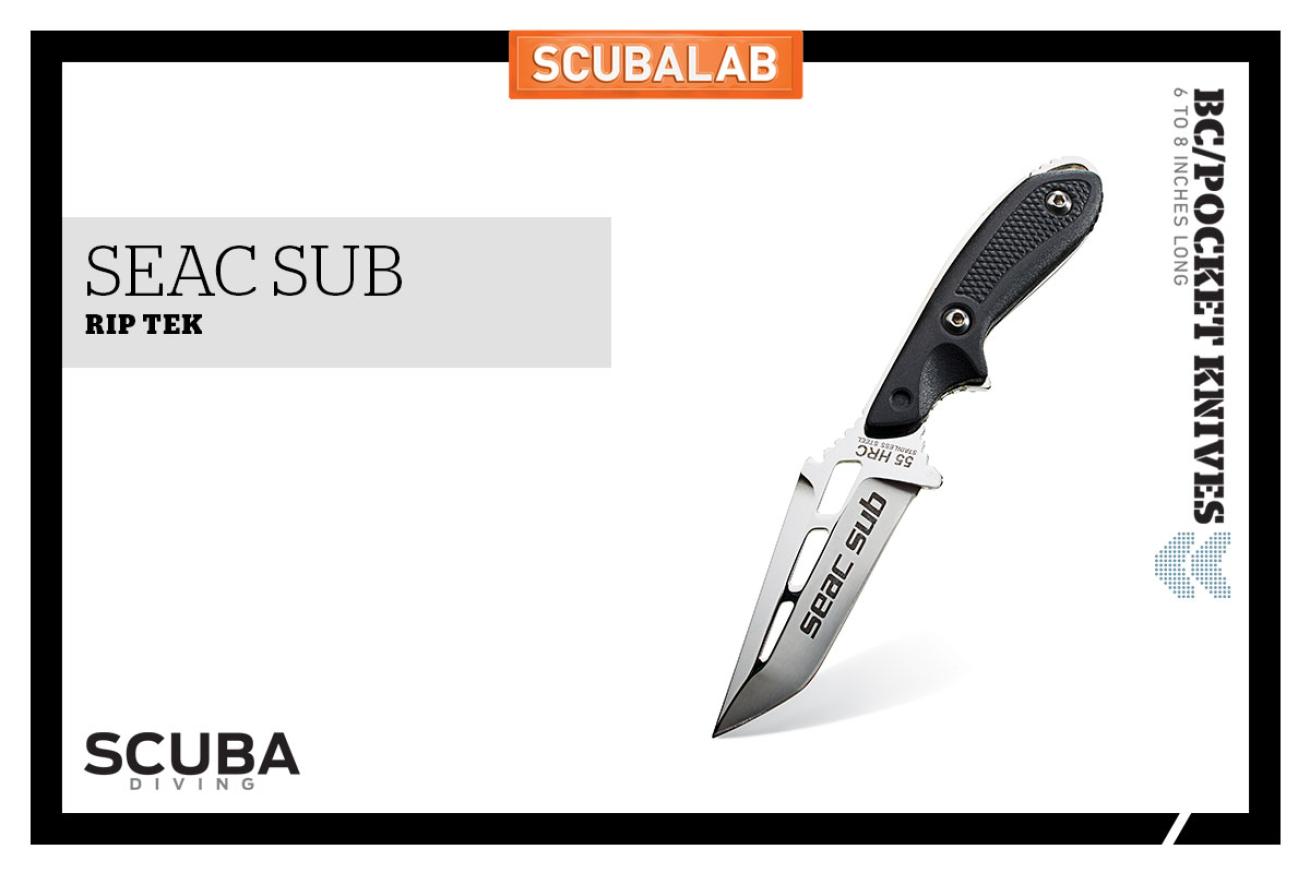
Michael KrausSeac Sub: Rip Tek
One of several Seac models that differs only in blade shape, the Rip Tek has a straight-back stainless blade with a 3-inch cutting surface that, as with the Rip Race, made short work of our test lines. Like its drop-point brother, the Rip Tek has a thick, stout blade and a handle that’s removable for cleaning.
$97; seacsub.com

Scuba Diving StaffResolution: I will subscribe to Scuba Diving magazine. ;)
You want a dive knife that is sharp, strong and resistant to corrosion. We evaluated new knives in a variety of designs, materials and sizes so you'd know how they stand up to the rigors of dive use.
Choosing the Best Material
Finding the perfect metal for a dive knife is almost as much alchemy as metallurgy. Whether made from 1) titanium or one of the many types of 2) stainless or specialty steels now used, all knives have to strike a rock/paper/scissors sort of balance: hard enough to hold an edge; strong enough to resist breaking; and able to avoid corrosion. With stainless, reducing carbon content increases corrosion resistance but at the expense of hardness needed to stay sharp. Materials like titanium and some specialty steels have extreme resistance to corrosion but may not hold an edge like high-carbon steels that would quickly rust in salt water.
How We Test
We evaluated each dive knife’s ability to cut several types of line: 1⁄4-inch diamond braid nylon-poly, 1⁄4-inch hollow-braid poly, 1⁄2-inch braided nylon and heavy (.095-inch) plastic trimmer line. While we could have used tougher lines (such as Kevlar), we chose the lines we did because they’re the kind of cheap, often-discarded, long-lived materials that we encounter diving. We made a first cut through a hand-held loop of each type of line, and rated the cutting ability from 1 to 5 (1=Poor and 5=Excellent). Next we cut a double thickness of each line, and then we made 20 repetitive cuts of all lines on a block of soft wood, and followed that with more cuts of hand-held loops (since you’re not likely to find a cutting board when diving). We also scored each knife on the following: the security of its sheath or folding/locking mechanism; the ease of deploying/stowing the knife barehanded and with 5 mm gloves; how it withstood 10 pounds of weight when wedged 1-inch deep in a block of wood; and its overall fit and finish.
Does Size Matter?
The short answer is yes, but not in the way you might expect. Some of the smaller blades here cut as well as the largest. But big dive knives have room for big, comfortable grips — something you notice after cutting nearly 200 feet of test line.
Finding the Perfect Style and Size
There are knives designed for dispatching speared fish, knives that will endure prying and pounding, knives that will cut fouled lines without hurting you or your gear, and knives so small, they stow anywhere. But like any tool, no single dive knife can be the best at everything. Whether your dive style means you need a knife that works for spearfishing and kelp diving, or one that stays safely out of the way until the day you find yourself tangled in discarded fishing line, there are many options available. Assess your needs honestly and shop accordingly.
Best Blade Design
How you’ll actually use your knife or cutting tool is what determines the best design for you. If you’re carrying it for emergency use to clear away entanglements like fishing line, a very compact cutting tool that stows out of the way might be the best option. But if you need a tool for heavy cutting, sawing or prying, you need a really rugged dive knife with a thick, tough blade and a secure grip. And if you’ll be using your knife for spearfishing as well as general diving, you need a blade that can cut well but also quickly dispatch a speared fish, and it’s handy if it has tools for repairing or freeing spear points. Also be sure that the knife’s grip fits your hand properly (including with any gloves you dive with).
Fighting Rust
Today’s dive knives resist rust far better than those of just a few years ago. Titanium and some specialized steel alloys are practically immune to corrosion, and even less-resistant steels can last a long time with proper care. First, rinse the knife and sheath thoroughly as soon as possible after use, being sure to remove any accumulated salt beneath the handle or hardware. If the knife handle is removable, pull it of for cleaning. Next, dry the knife completely, rubbing the blade and metal parts with a soft cloth to buff away any signs of corrosion or stain. Finally, spray the blade with a very light coat of silicone lubricant (don’t use petroleum oil), and store it in its sheath.
Looking for more ScubaLab testing? Check out more of our gear reviews:
SCUBALAB 2015: Travel Gear Review
SCUBALAB 2014: Gear of the Year
SCUBALAB 2014: Dive Bag Review
SCUBALAB 2014: Regulator Review
SCUBALAB 2014: BC Review
SCUBALAB 2014: Dive Lights Review
SCUBALAB 2014: Wetsuit Review
SCUBALAB 2013: Fins Review
SCUBALAB 2013: Mask Review
SCUBALAB 2013: Regulator Review

